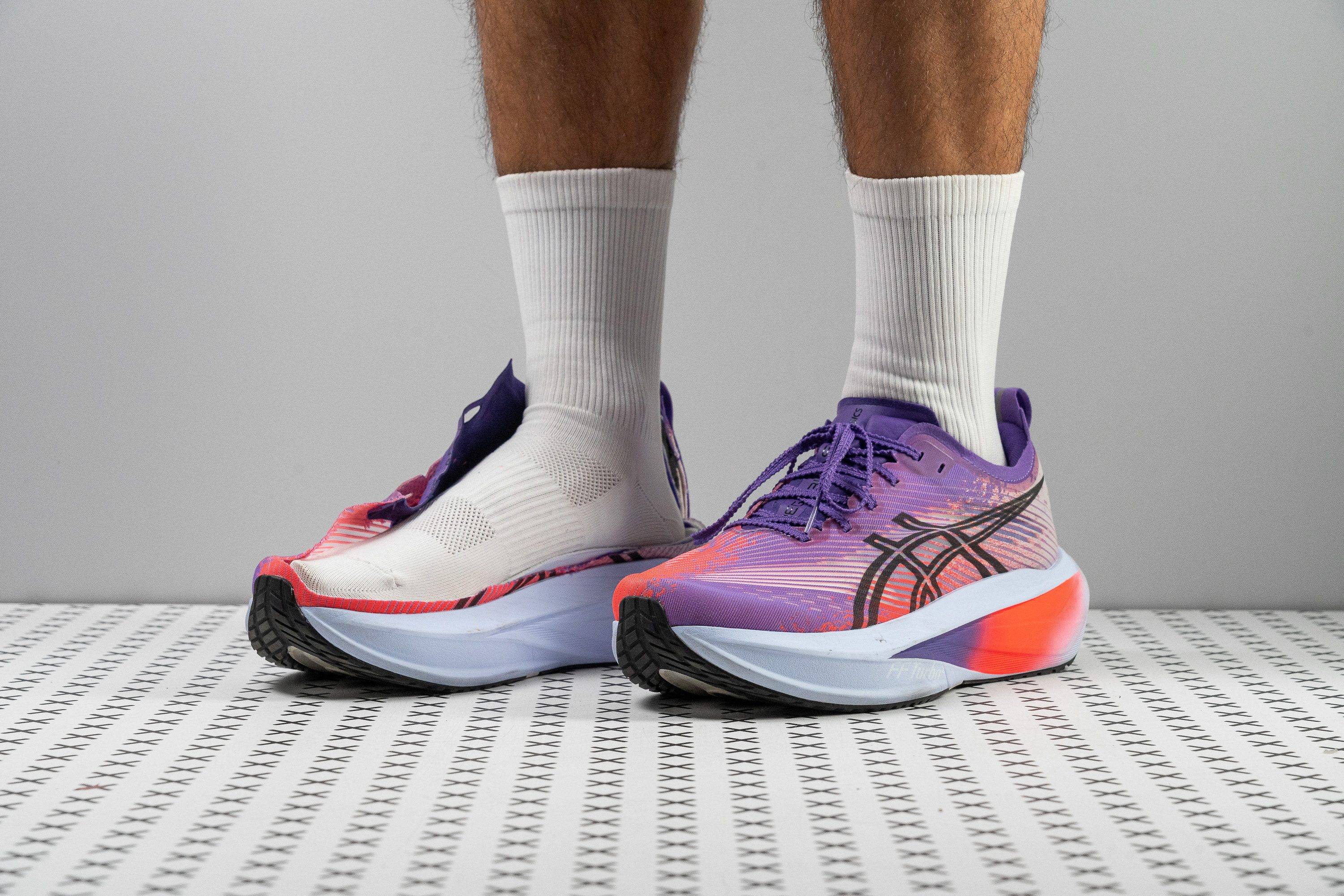Our verdict
- Top pick in best marathon running shoes
- Top pick in best ASICS running shoes
Pros
- Outstanding energy return
- Exceptional impact protection
- Durable, grippy outsole rubber
- Astonishingly low weight
- Performs at any pace and distance
- Breathable, lightweight upper
- High-quality materials from heel to toe
- Suitable for all footstrikes
- Top performance without a carbon plate
Cons
- Extremely expensive for a training shoe
- Limited outsole coverage
- Poor toebox durability
Audience verdict
- Top 13% most popular running shoes
Comparison
The most similar running shoes compared
+ + Add a shoe | |||||
|---|---|---|---|---|---|
| Audience score | 83 Good! | 82 Good! | 90 Superb! | 79 Good! | |
| Price | £220 | £180 | £210 | £170 | |
| Pace | CompetitionTempo | Tempo | Daily runningTempo | Daily runningTempo | |
| Shock absorption | High | High | Moderate | High | |
| Energy return | High | High | High | Moderate | |
| Traction | High | High | High | High | |
| Arch support | Neutral | Neutral | Neutral | Neutral | |
| Weight lab Weight brand | 7.7 oz / 218g 7.9 oz / 224g | 8.5 oz / 241g 8.4 oz / 238g | 8.9 oz / 252g 8.8 oz / 250g | 10 oz / 283g 9.9 oz / 281g | |
| Lightweight | ✓ | ✓ | ✗ | ✗ | |
| Drop lab Drop brand | 9.9 mm 8.0 mm | 10.6 mm 8.0 mm | 8.2 mm 8.0 mm | 10.6 mm 6.0 mm | |
| Strike pattern | HeelMid/forefoot | Heel | HeelMid/forefoot | Heel | |
| Size | True to size | True to size | True to size | True to size | |
| Midsole softness | Soft | Soft | Soft | Soft | |
| Difference in midsole softness in cold | Small | Normal | Small | Small | |
| Toebox durability | Bad | Decent | Good | Good | |
| Heel padding durability | Good | Good | Good | Decent | |
| Outsole durability | Good | Good | Good | Good | |
| Breathability | Moderate | Breathable | Breathable | Moderate | |
| Width / fit | Medium | Medium | Medium | Medium | |
| Toebox width | Medium | Medium | Medium | Medium | |
| Stiffness | Stiff | Moderate | Stiff | Moderate | |
| Torsional rigidity | Stiff | Stiff | Stiff | Stiff | |
| Heel counter stiffness | Moderate | Stiff | Moderate | Moderate | |
| Rocker | ✓ | ✓ | ✓ | ✓ | |
| Heel lab Heel brand | 45.1 mm 45.0 mm | 37.4 mm 36.0 mm | 42.8 mm 45.0 mm | 45.6 mm 46.0 mm | |
| Forefoot lab Forefoot brand | 35.2 mm 37.0 mm | 26.8 mm 28.0 mm | 34.6 mm 37.0 mm | 35.0 mm 40.0 mm | |
| Widths available | NormalWide | NormalWide | NormalWide | Normal | |
| Orthotic friendly | ✓ | ✓ | ✓ | ✓ | |
| Season | All seasons | SummerAll seasons | SummerAll seasons | All seasons | |
| Removable insole | ✓ | ✓ | ✓ | ✓ | |
| Ranking | #265 Bottom 28% | #285 Bottom 22% | #74 Top 20% | #315 Bottom 14% | |
| Popularity | #48 Top 13% | #39 Top 11% | #21 Top 6% | #46 Top 13% |
Who should buy
Based on our lab tests, the ASICS Megablast is a great choice for:
- Runners seeking one shoe that can handle everything from daily training to interval sessions and races.
- Those who love the unique feel of supershoe foams but prefer a plate-free ride.
- Fans of the Superblast series who wanted something even lighter and more responsive. The Megablast delivers exactly that.
- Marathoners seeking a supertrainer built for long runs and tempo workouts that offers outstanding energy return and shock absorption.
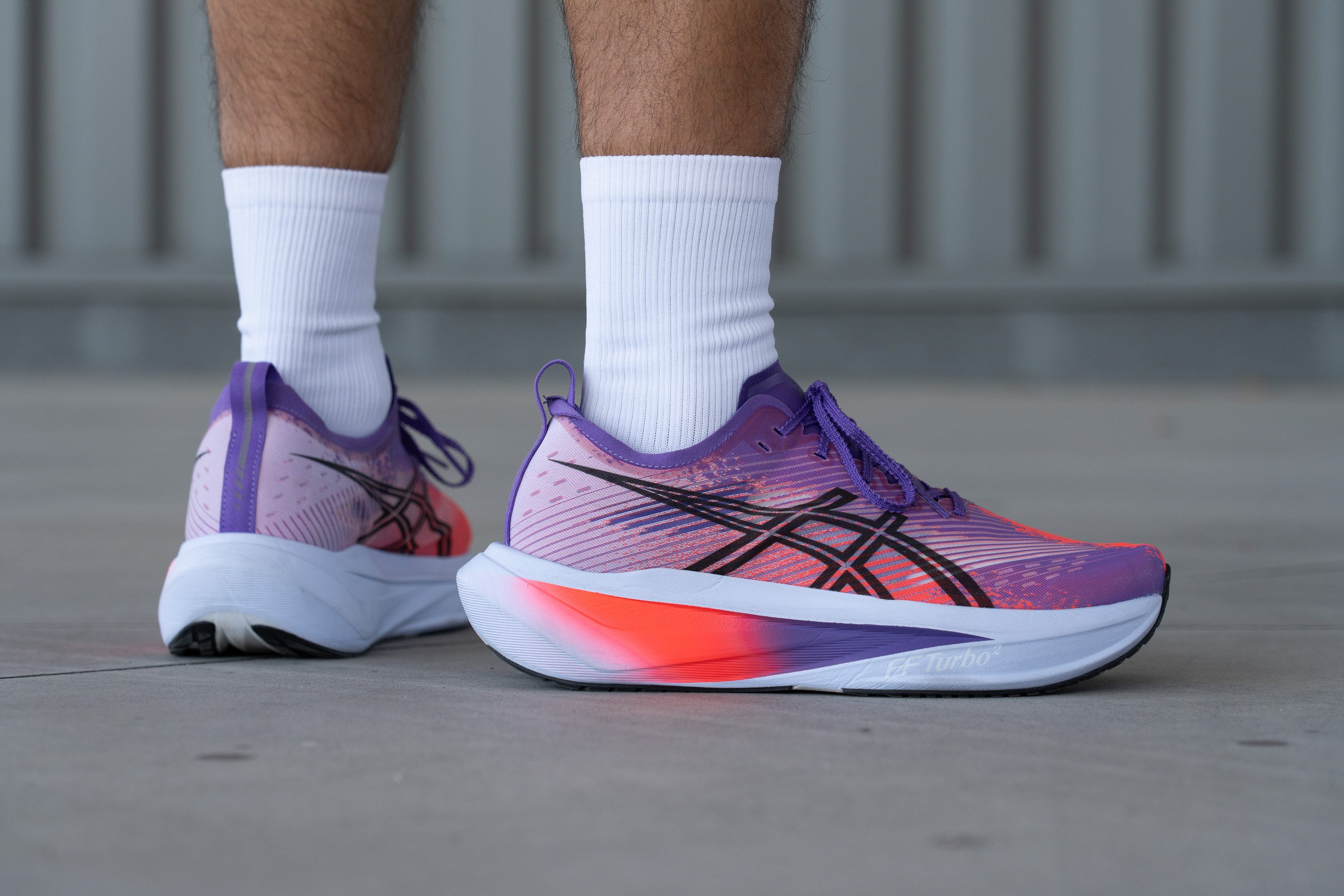
Who should NOT buy
We think the ASICS Megablast carries a sky-high price that’s hard to justify for many runners. You can get comparable performance for much less with the Adidas Adizero EVO SL, though with lower-quality materials. Or you can go for the ASICS Novablast 5 if energy return isn’t your main concern.
We also found that the Megablast’s stiffness might be a drawback for those who enjoy a more flexible, forgiving ride. In our view, the Saucony Endorphin Speed 5 is a fantastic alternative, offering excellent energy return, better flexibility, and a cheaper price.
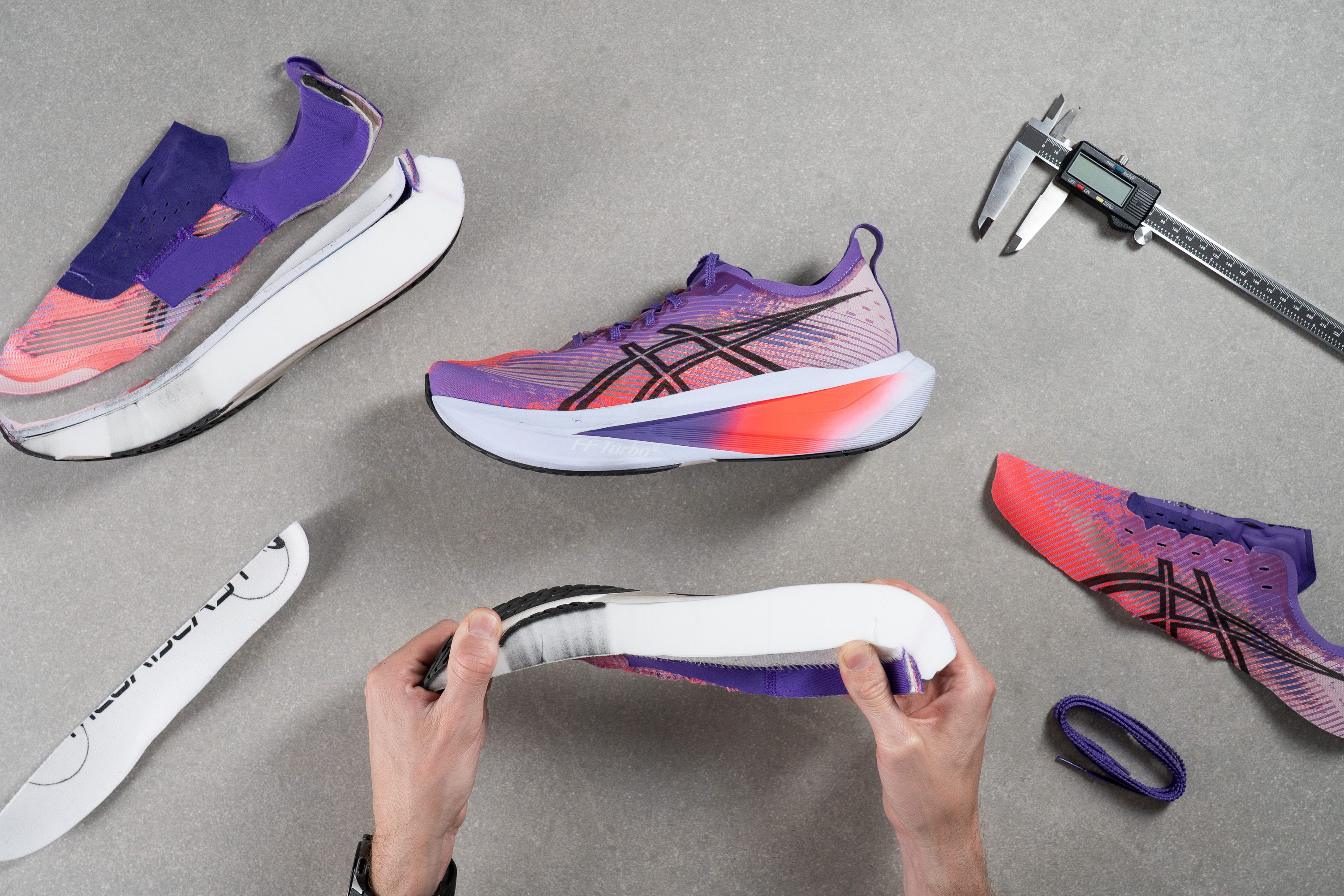
Cushioning
Shock absorption
Just by looking at the Megablast, it’s clear that it has a massive midsole. And when premium foam meets a high stack, the result is always outstanding impact protection.
In our lab, we measured an impressive 160 SA in the heel and a record-breaking 144 SA in the forefoot. With numbers like these, the Megablast can comfortably handle any runner, at any distance.
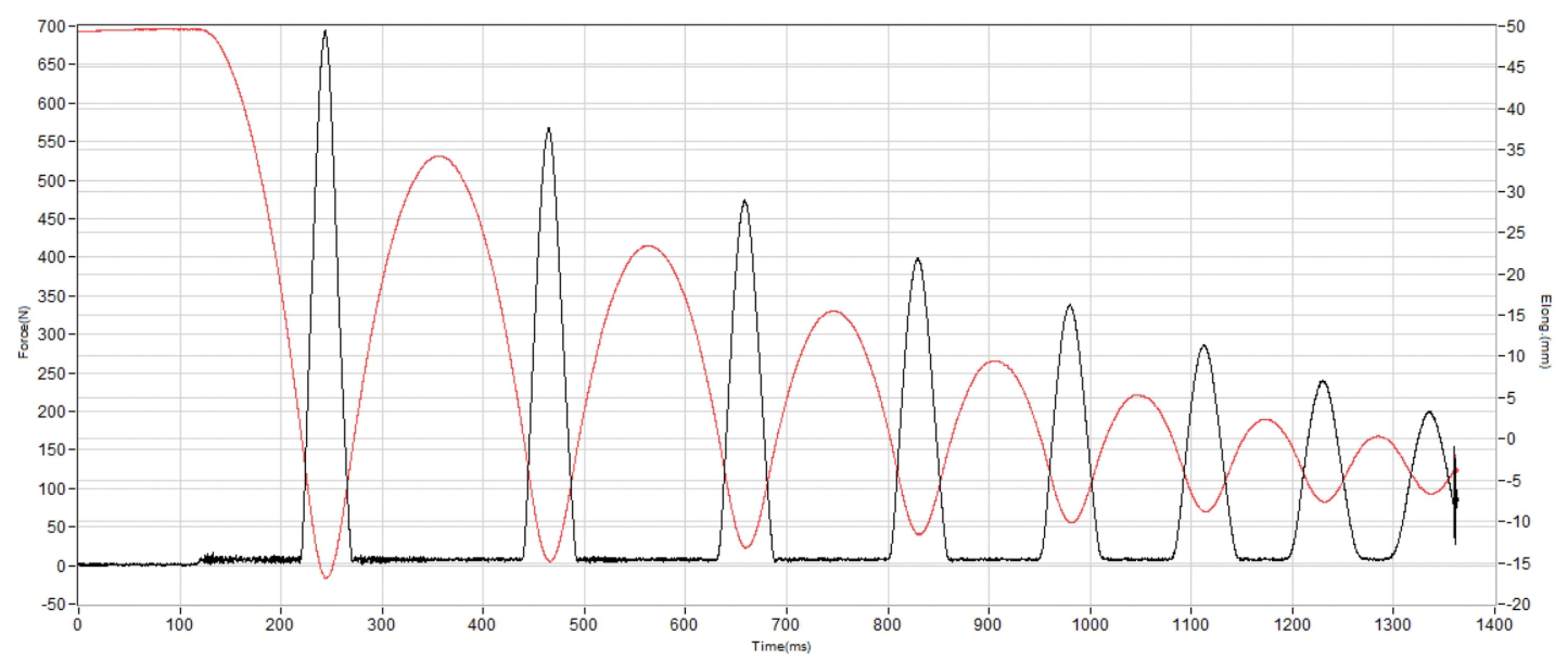
| Megablast | 160 SA |
| Average | 129 SA |
Energy return
It can also handle any pace. This shoe was conceived by ASICS as the ultimate training shoe, but with 73.0% energy return in the heel and 73.8% in the forefoot, it’s perfectly suited for any workout your imagination creates. A long run finishing with 10K at marathon pace? It’s perfect for that. Two 5K tempo intervals? FF Turbo² absolutely shines.
Going even further, we think that it can serve as a racing shoe for a huge percentage of runners. If you dislike carbon plates or they tend to cause discomfort like Morton's neuroma, this is a fantastic pick. Of course, for those chasing the absolute top-tier performance, a supershoe like the ASICS Metaspeed Sky Tokyo remains a better pick... but the Megablast’s numbers are really good.
| Megablast | 73.0% |
| Average | 58.6% |
Heel stack
The sky-high numbers we recorded in our shock absorption test come from the Megablast’s maximalist stack height, as its name suggests. We measured 45.1 mm of material under the heel, making it one of the tallest shoes we’ve ever tested in the lab.
However, this ultra-cushioned setup can also be a downside. Those who prefer a more natural, ground-sensitive ride will probably find it too elevated and disconnected from the surface.
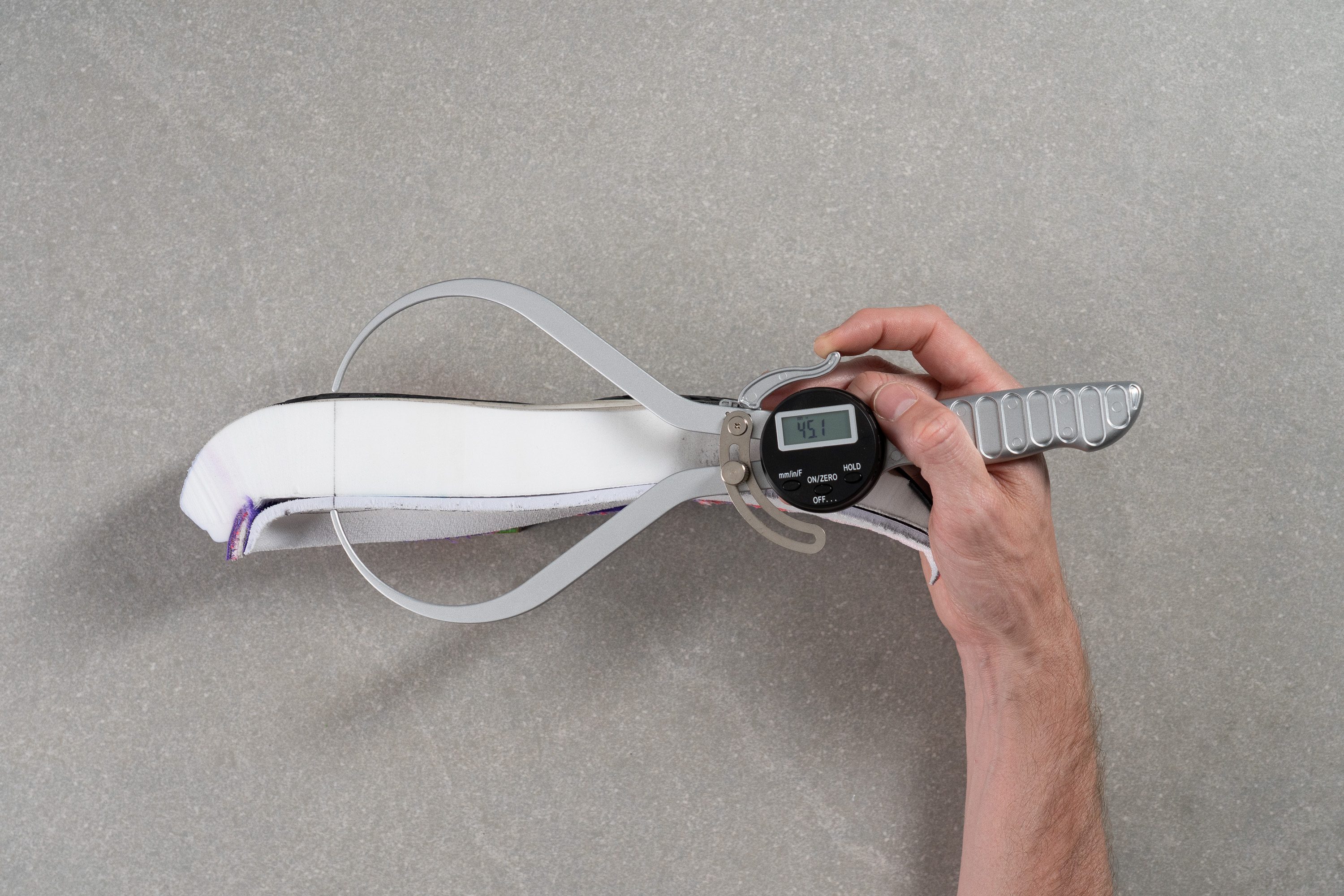
| Megablast | 45.1 mm |
| Average | 34.8 mm |
Forefoot stack
The forefoot is also impressively stacked with 35.2 mm of foam. We’ve started to normalise these ultra-thick builds, but just a few years ago, such a measurement would’ve felt unreal.
We believe that midfoot and forefoot strikers will love this setup for recovery days or long runs. The FF Turbo² foam never fades, and there’s always that lively bounce waiting with every stride.
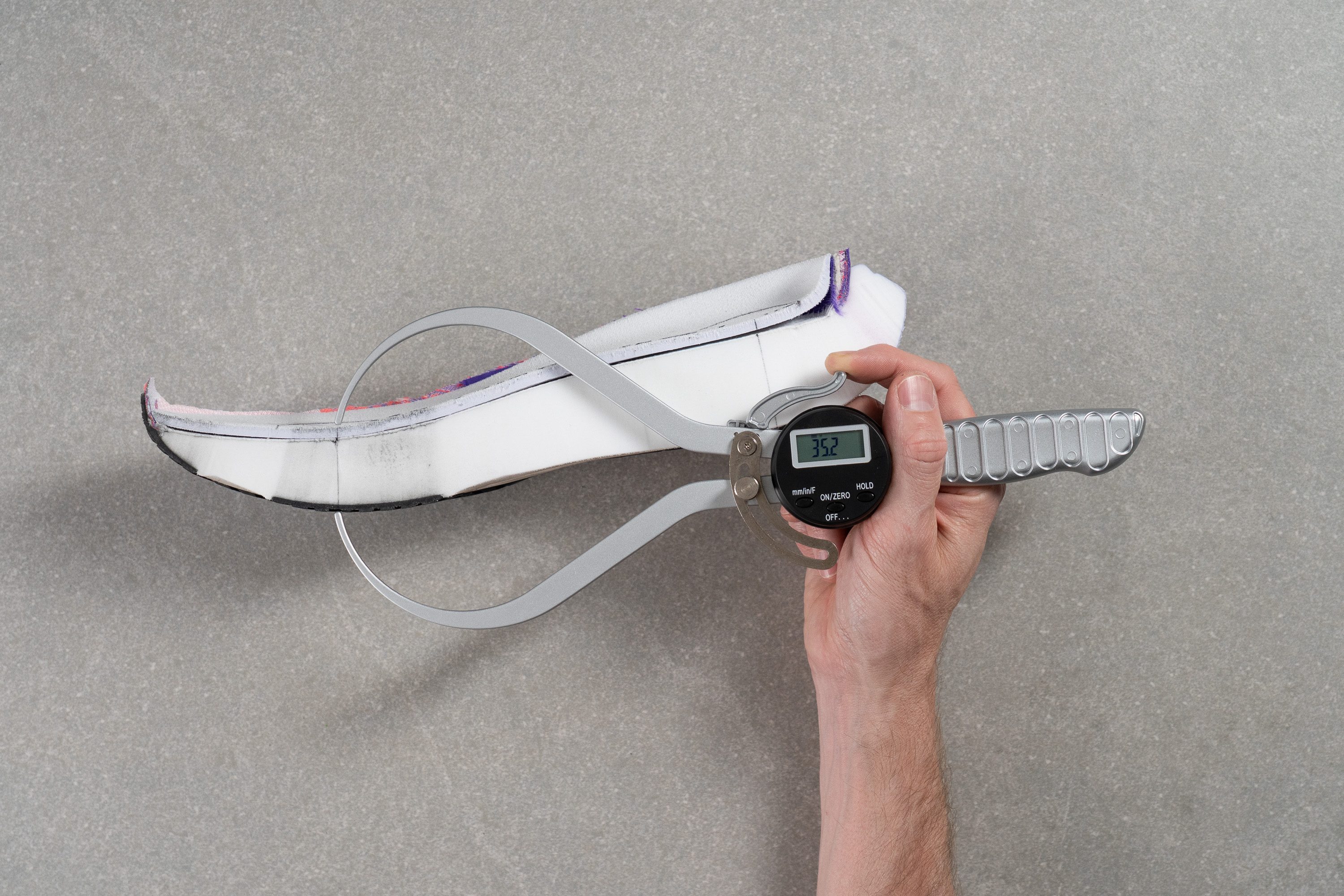
| Megablast | 35.2 mm |
| Average | 26.2 mm |
Drop
We discovered that the Megablast has a slightly higher drop than advertised. Instead of 8 mm, we measured 9.9 mm.
This makes it slightly more appealing for heel strikers, but with so much foam under the forefoot, forefoot and midfoot runners won’t experience any bottoming out despite the higher drop. Still, if you prefer a lower or mid-drop setup, the Megablast might not feel ideal for your stride and you should check the Saucony Endorphin Trainer instead.
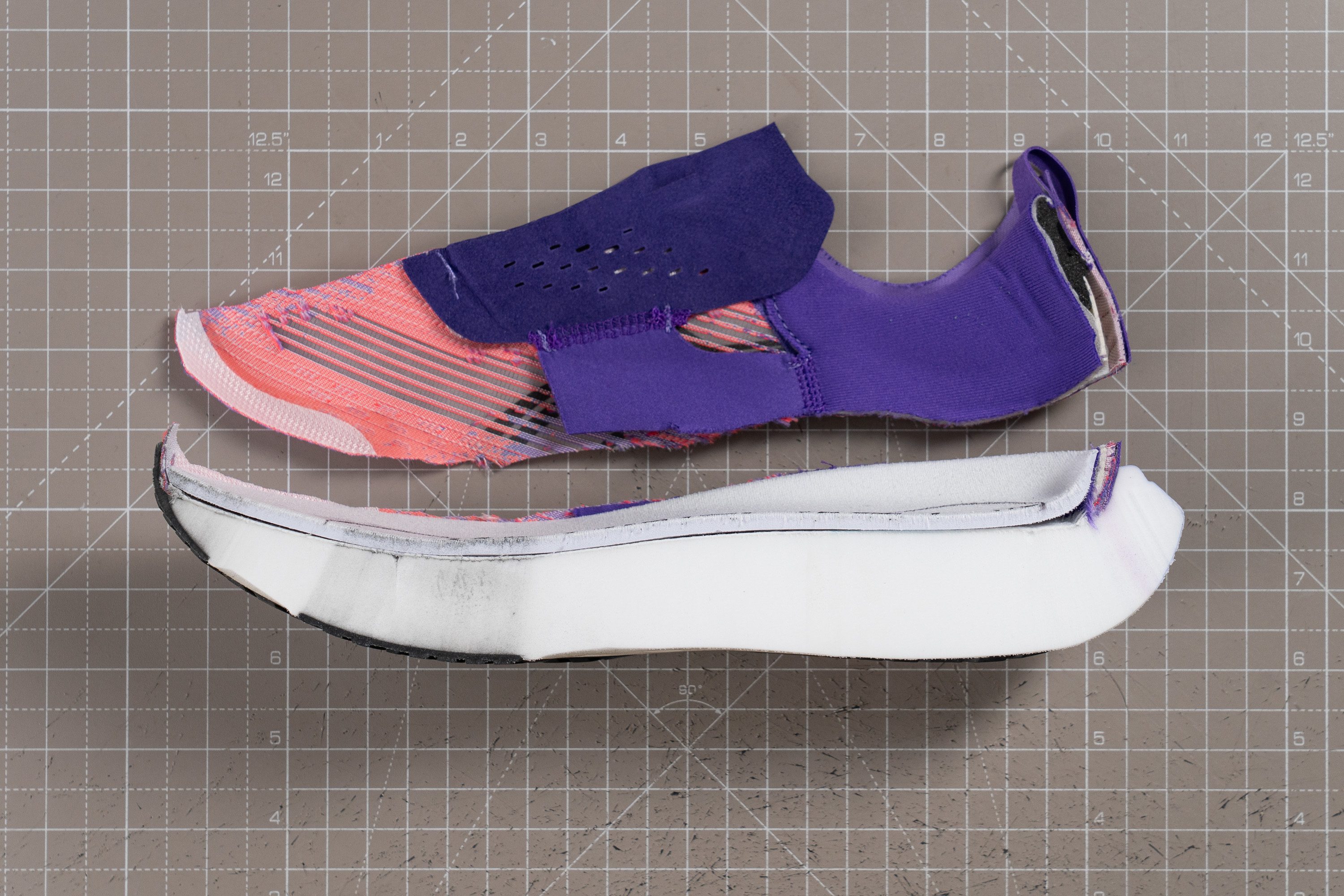
| Megablast | 9.9 mm |
| Average | 8.6 mm |
Midsole softness
The recipe behind this shoe is pretty simple: ASICS took the Superblast 2 and aimed to improve it in every possible way. The most logical first step was replacing the less responsive FF Blast+ layer and use a single slab of superfoam. But instead of going with FF Turbo+, ASICS surprised us with something new: FF Turbo².
Right now, the foam market is moving at lightning speed—check out our guide to stay up to date—and ASICS stands at the forefront of innovation right now. With FF Leap in the Metaspeed Ray and this FF Turbo², the brand added two A-TPU foams that deliver outstanding energy return.
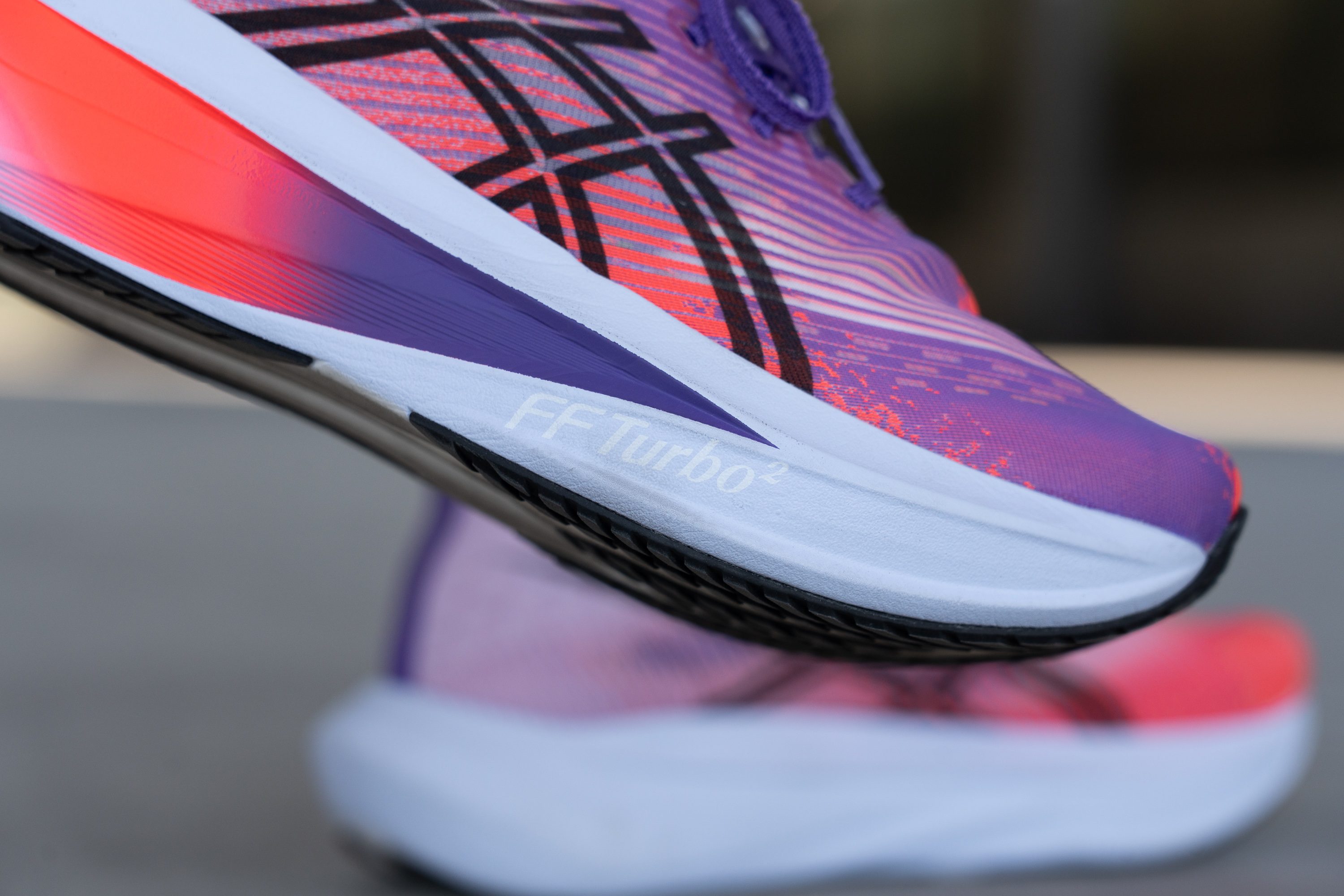
But, why not just use FF Leap? Because it’s too soft and less durable. FF Turbo² basically is a training-oriented version of FF Leap: slightly firmer, but still soft at 15.5 HA. And honestly, it’s so good that we can’t wait to see what ASICS brings next.
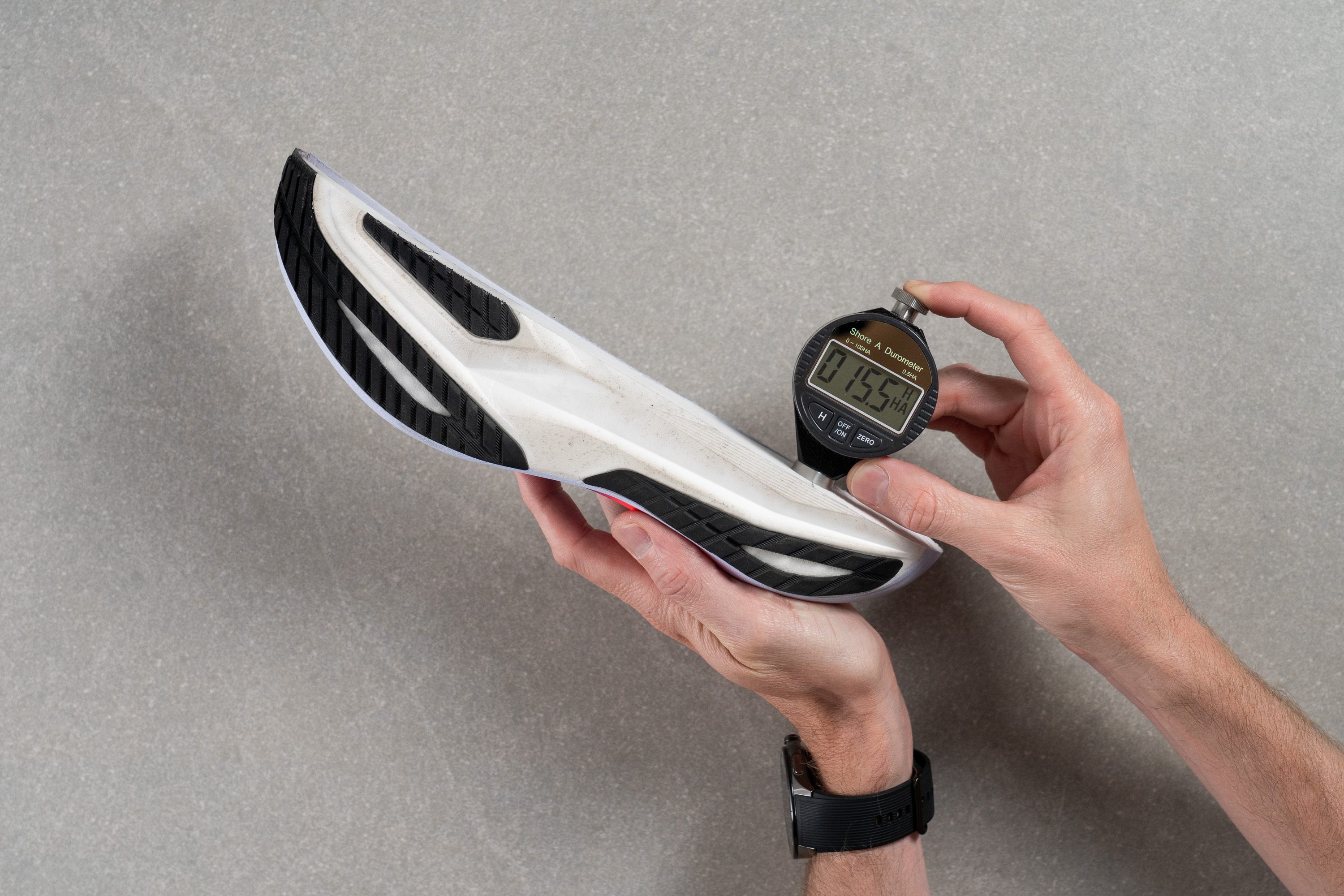
| Megablast | 15.5 HA |
| Average | 20.4 HA |
Rocker
Any shoe with a towering, maximalist stack like the ASICS Megablast needs a rockered geometry to keep transitions fluid—otherwise, the forefoot becomes too stiff to roll naturally.
From our lab shot above, it’s clear that ASICS went for it with a late-stage rocker design. The heel and forefoot feature a dramatic upward curve for a smooth, fast-forward motion, while the midfoot stays completely flat for added stability, a small but crucial detail.
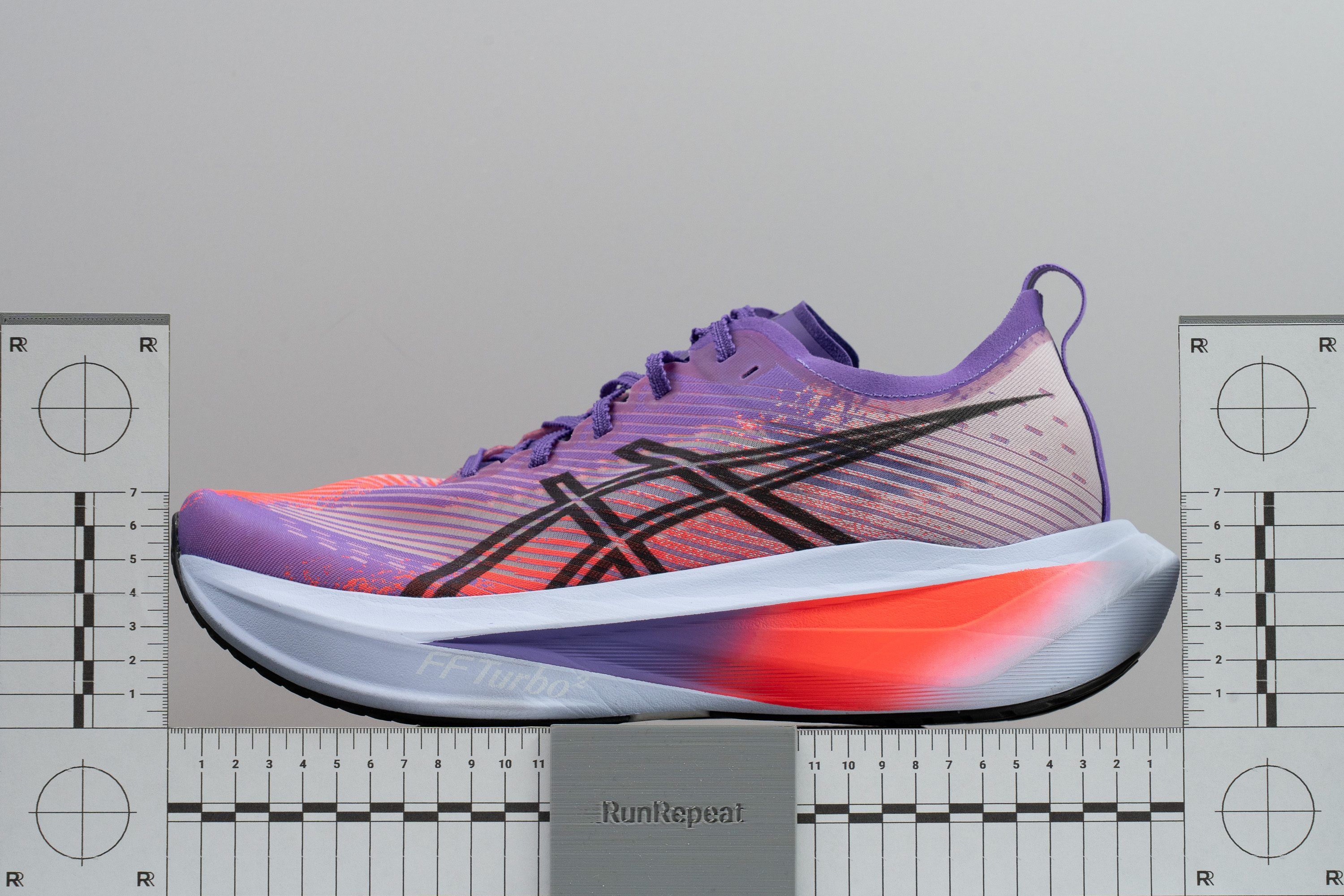
Size and fit
Size
ASICS Megablast fits true to size (50 votes).
Width / Fit
At first, we noticed that the Megablast felt quite similar to the Superblast 2, though maybe a bit roomier thanks to its ultra-thin, minimalist upper. However, we trust data over feelings—and you should too!
After our gel mould solidified in the fridge, we measured 93.7 mm of internal width. That's very close to the average but slightly on the snug side.
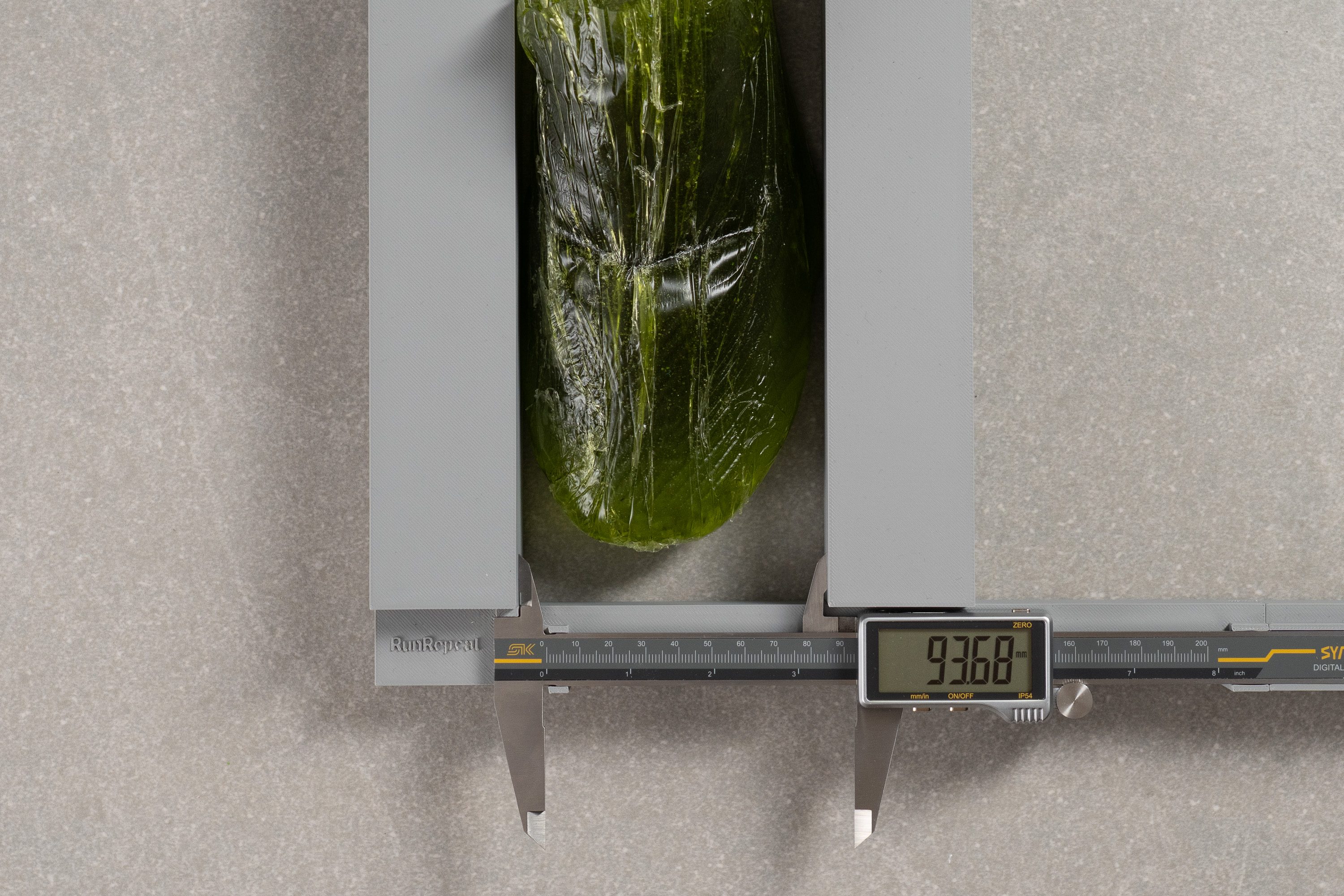
| Megablast | 93.7 mm |
| Average | 95.1 mm |
Toebox width
Where the fit differs a bit from the Superblast 2 is in the toebox width.
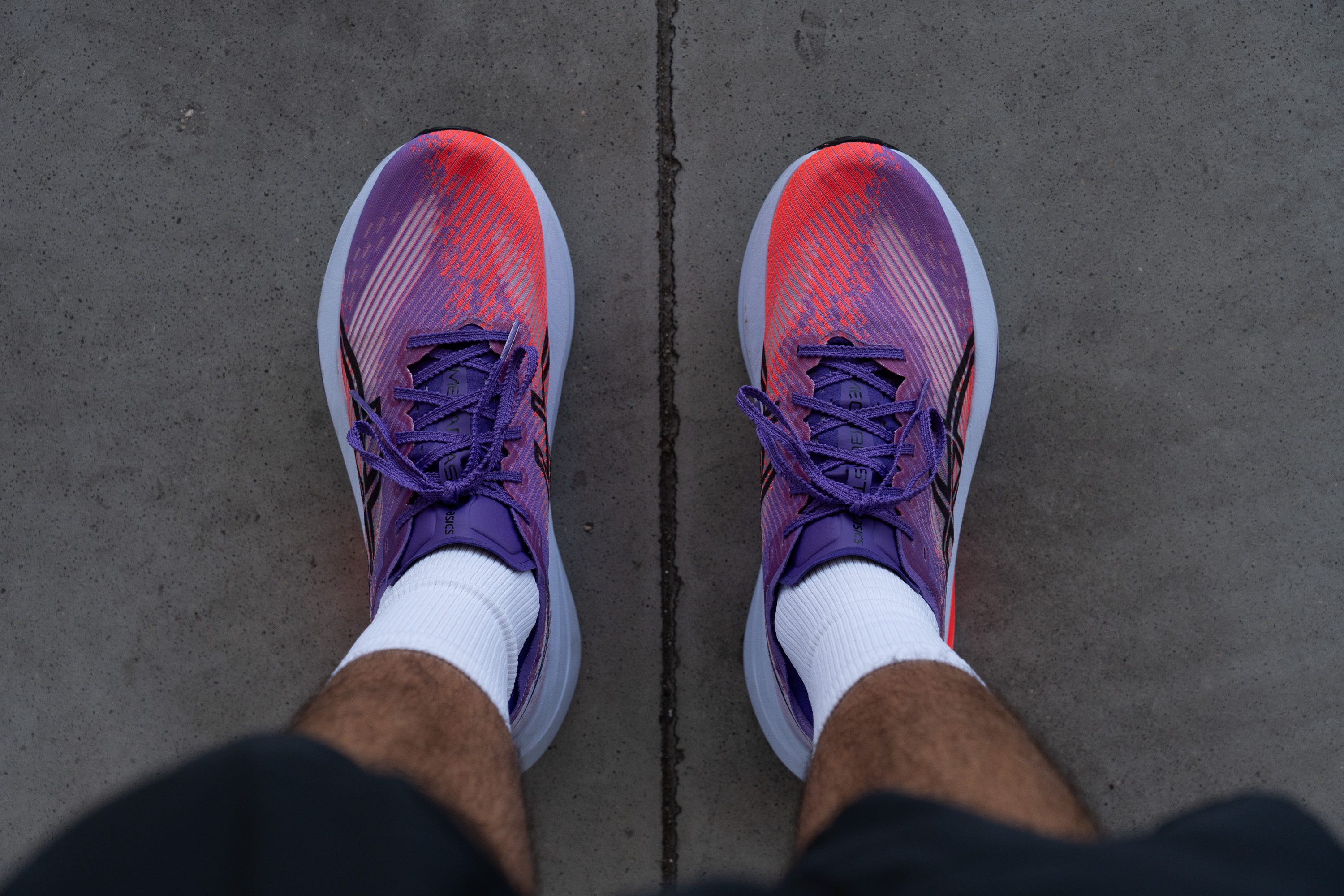
We measured a roomier 74.3 mm here, with a less tapered design that gives your pinky toe extra space. This is a key detail for any run lasting more than 90 minutes, although for those with wide feet, it’s likely still not enough, and sizing up would be the only option.
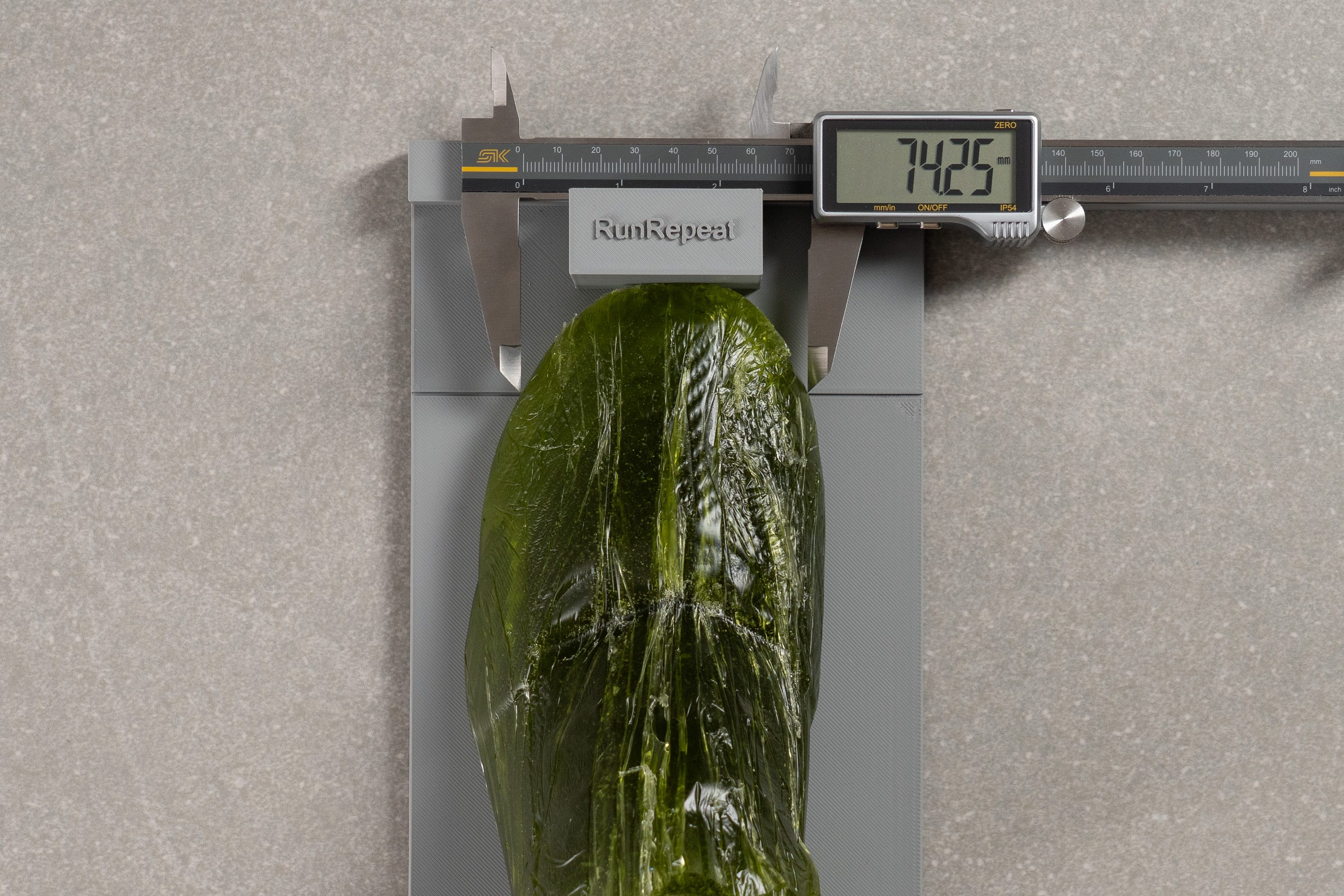
| Megablast | 74.3 mm |
| Average | 73.3 mm |
Toebox height
We measured the toebox volume at 24.2 mm, slightly below average, giving the shoe a more secure than roomy fit.
However, since the upper is ultra-light and very thin, it doesn’t create much pressure and remains comfortable. We believe ASICS aimed for a performance-focused yet still universal fit, which is not a coincidence since no wide version will be available.
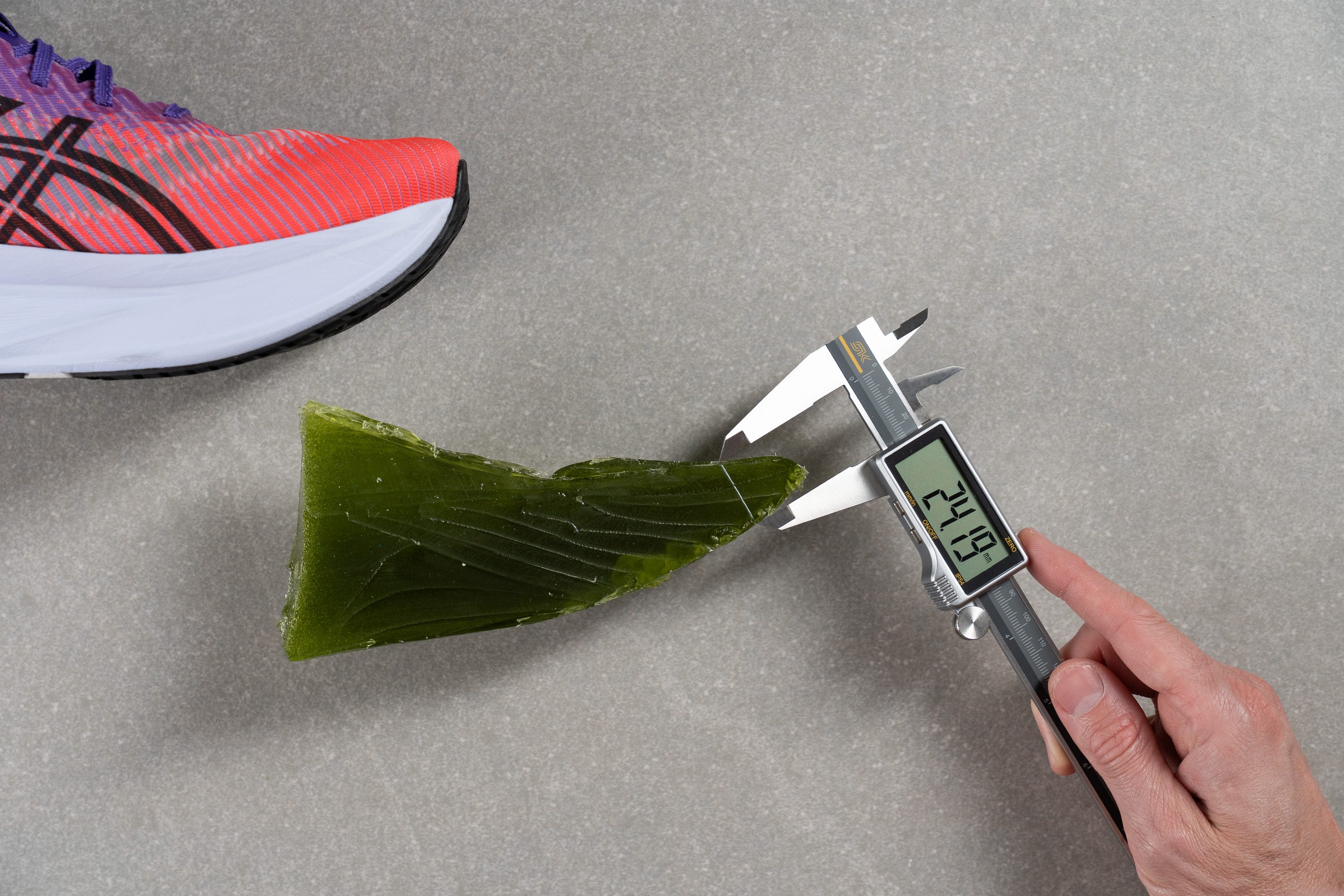
| Megablast | 24.2 mm |
| Average | 27.1 mm |
Traction / Grip
Traction test
After discovering that the Megablast uses ASICSGRIP rubber, we expected strong traction—and it delivered.
Scoring 0.80 in our test, it ranks among the best shoes we’ve evaluated in the lab. It performs confidently on both dry and wet roads, though we don’t recommend it for unpaved surfaces as it has too much exposed foam.
| Megablast | 0.80 |
| Average | 0.48 |
Outsole design
The outsole of the Megablast mixes exposed foam with carefully positioned black rubber patches. As seen in our photo, coverage is really limited, and ASICS retained the signature forefoot pod design introduced in the Novablast series.
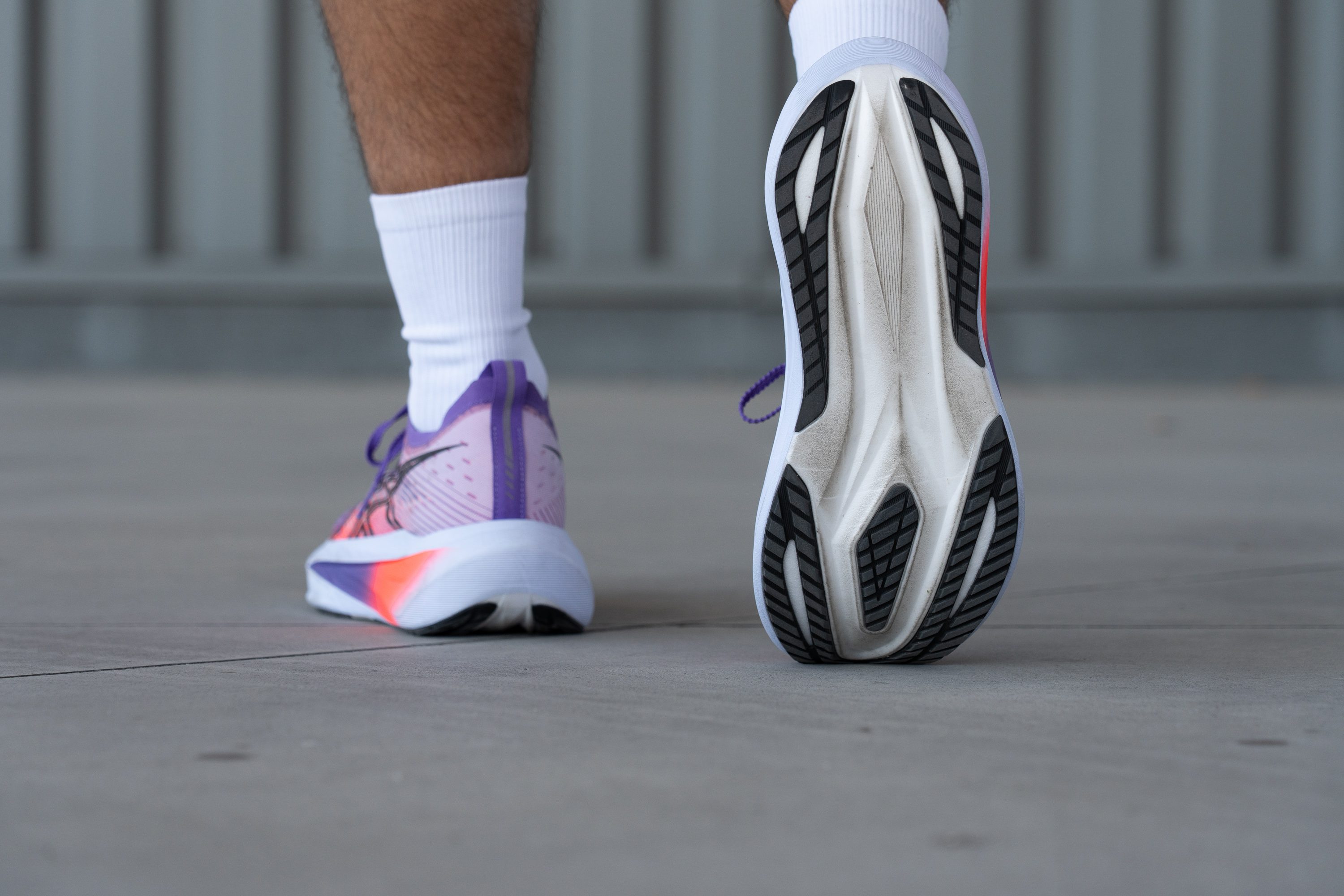
Flexibility / Stiffness
One potential drawback of the Megablast is its high stiffness. If you’ve worn the Superblast 1 or 2, the feeling is familiar. Basically, a massive stack like this simply can’t bend easily, which our 30-degree bend test confirmed at 18.8N.
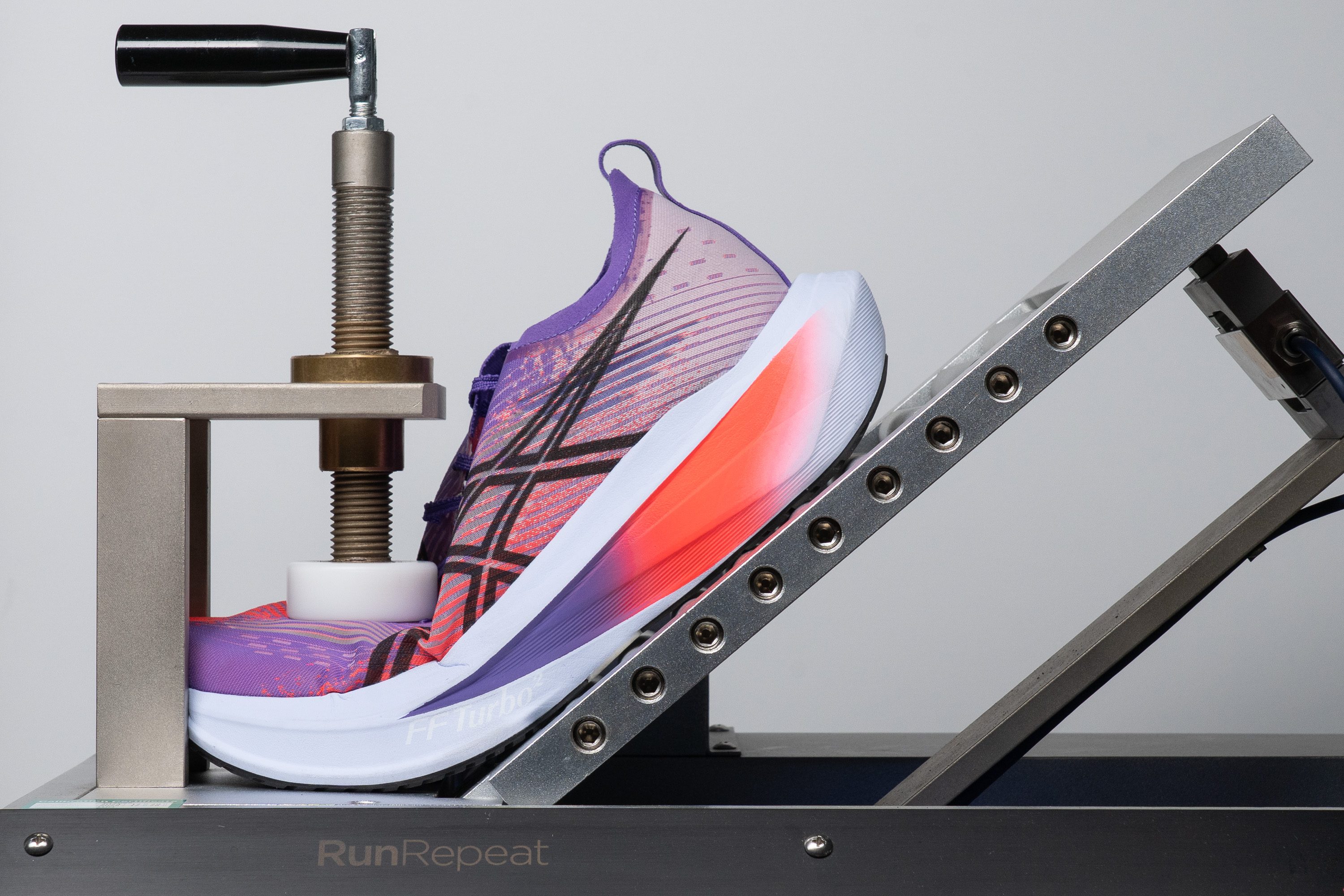
| Megablast | 18.8N |
| Average | 15.3N |
Weight
The weight of the Megablast is almost unbelievable at just 7.75 oz or 218g. For such a huge shoe, ASICS clearly worked hard here, pushing every part of the shoe to the absolute limit.
This ultra-light construction also makes the Megablast incredibly versatile. Racing? Absolutely, it’s lighter than the HOKA Rocket X 3. Daily runs or interval workouts? It works beautifully too.
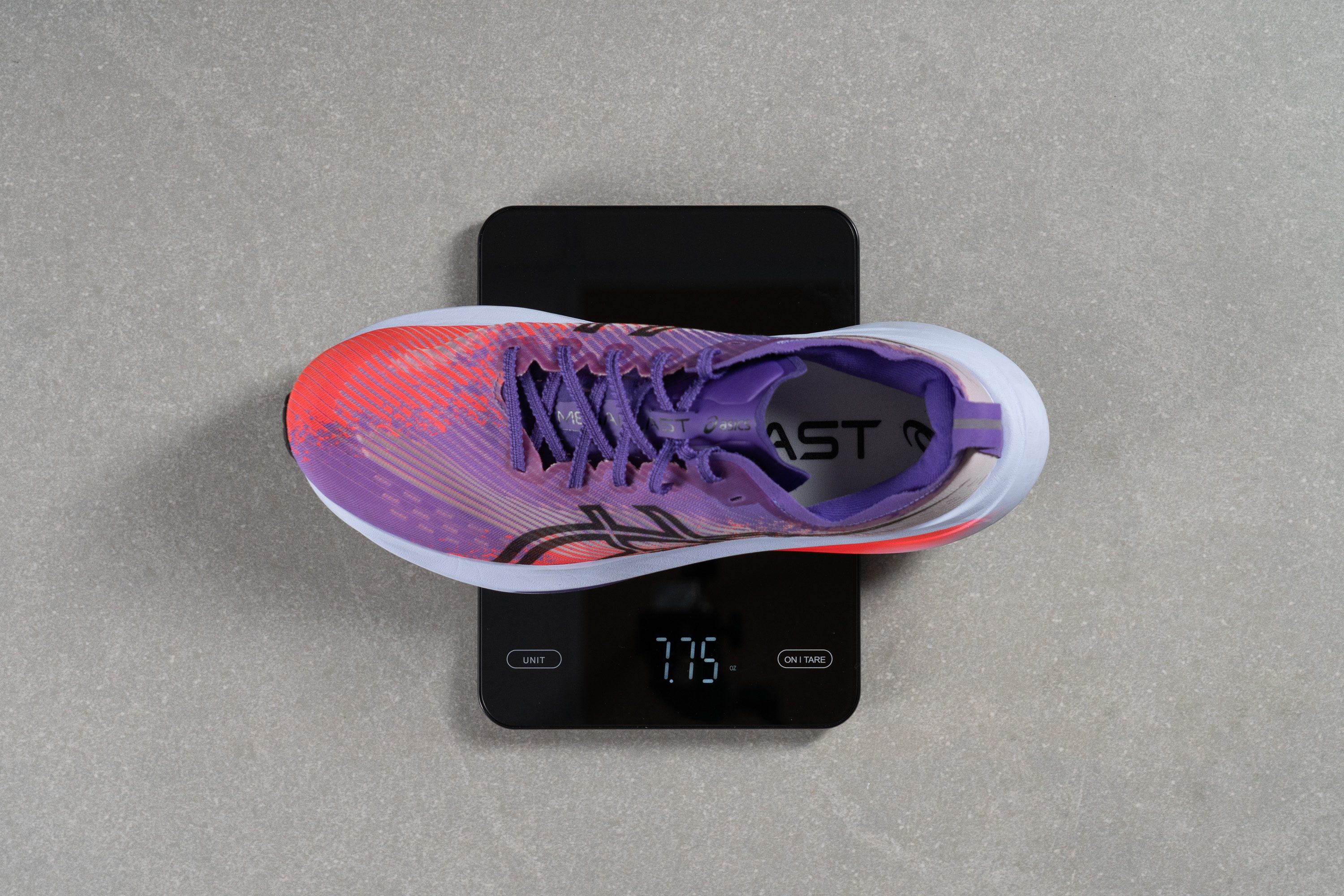
| Megablast | 7.7 oz (218g) |
| Average | 9.3 oz (264g) |
Breathability
When you ask runners to pay such a high price for a training shoe, every component must use the best materials, and ASICS didn’t disappoint us. The Megablast feels premium from heel to toe, showing clear attention to detail and quality.
We gave it a 4/5 score for breathability, meaning it performs well year-round depending on your sock choice and the season.
When we moved the cut upper over a LED light, its construction became clear. ASICS reinforced the heel and midfoot to improve support, while keeping the toebox extremely thin to reduce weight and increase ventilation for those summer long runs.
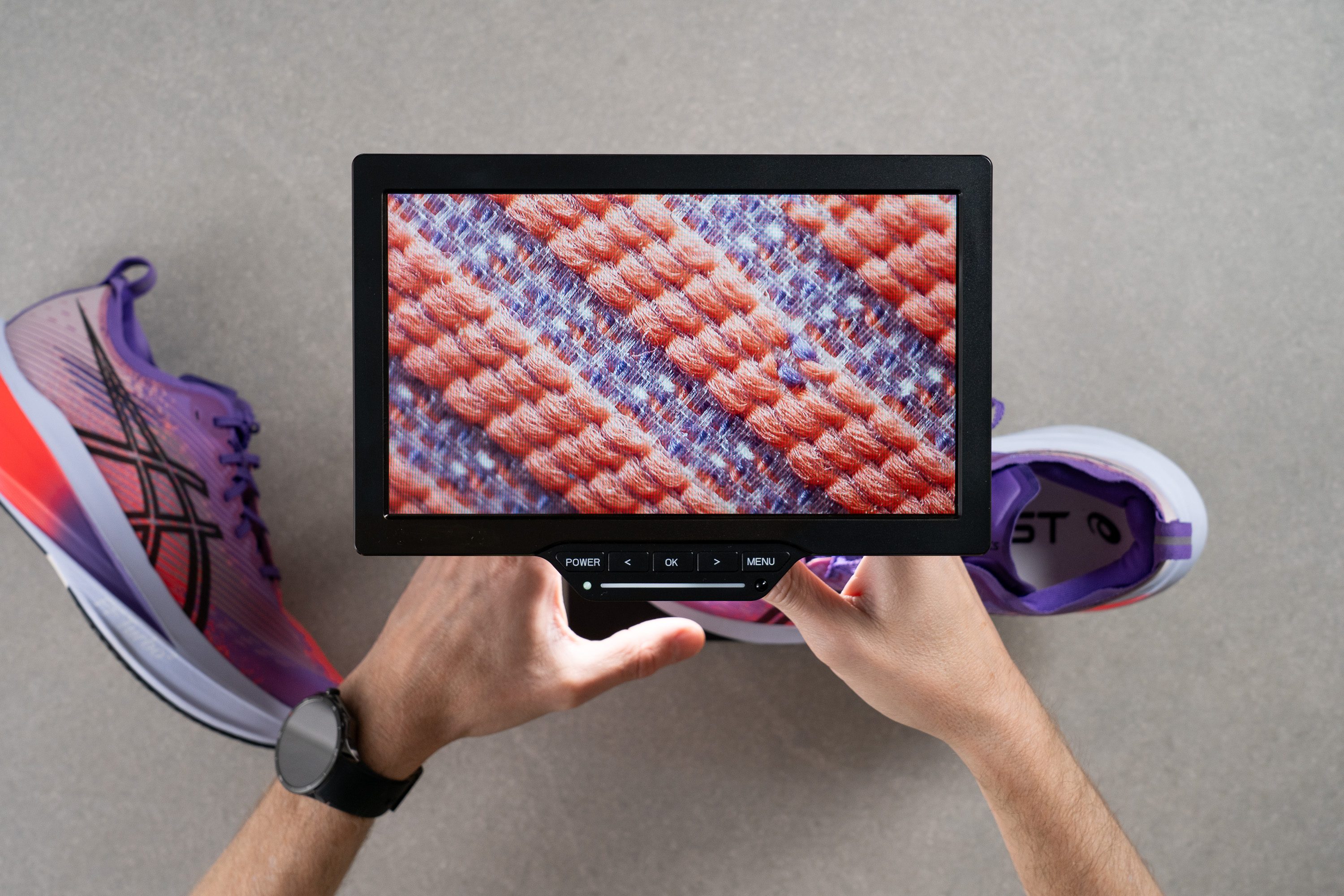
Under the microscope, the material looked incredibly well-crafted.
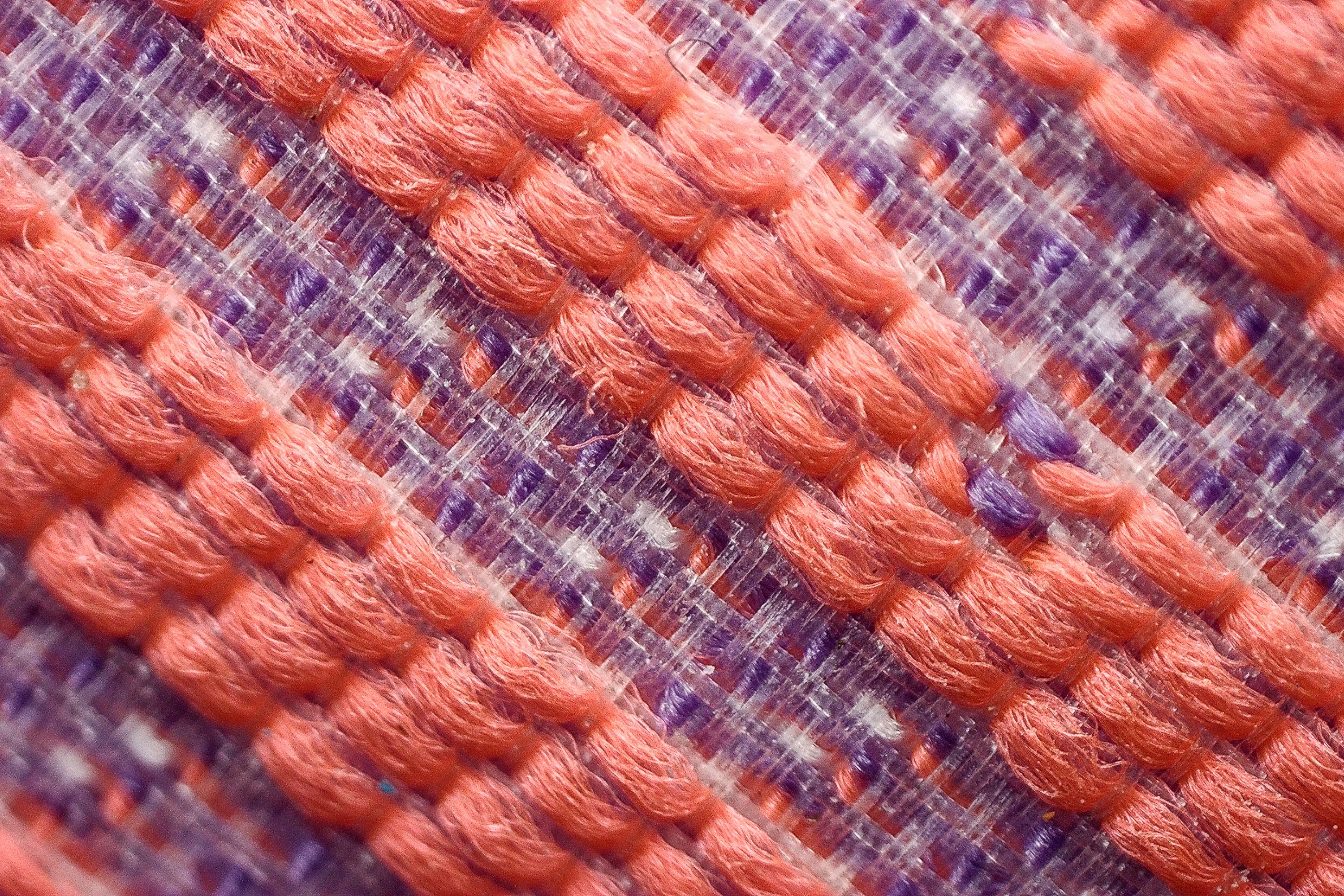
It’s clear ASICS used a high-end manufacturing process with precise stitching and strong fibres, resulting in a woven mesh upper that's miles ahead of some of its main competitors.
Comfort-wise, this upper works better for runners who prefer a low-bulk feel around the instep, as there’s no padding in the tongue. Yet the heel area felt to us surprisingly plush and protective, far more comfortable than most supershoes on the market.
| Megablast | 4 |
| Average | 3.7 |
Stability
Lateral stability test
We discovered that the ASICS Megablast offers a touch of stability thanks to its flat midfoot area, moderately raised sidewalls and high torsional rigidity. It performs well for neutral runners given its crazy-high stack, though it feels a bit less supportive than the Superblast due to its extra-bouncy foam.
For that reason, we recommend it only for neutral runners, as mild pronators may find that it lacks the necessary support.
Torsional rigidity
The Megablast doesn’t include a carbon plate, yet it performed here as if it did. It achieved a perfect 5/5 score in our test, a level of stiffness that contributes to maintain stability in such a tall shoe.
| Megablast | 5 |
| Average | 3.5 |
Heel counter stiffness
The heel counter feels very comfortable thanks to a thick foam pad inside, and its stiffness sits right at an average level at 3/5.
It’s a smart, safe design choice from ASICS, since a stiffer build could easily cause discomfort during long runs or fast races.
| Megablast | 3 |
| Average | 2.9 |
Midsole width - forefoot
One key factor for stability in modern supertrainers is the midsole flare in the forefoot and heel, where the foam extends outward to create a wider landing platform.
We discovered that the ASICS Megablast’s forefoot measures 117.9 mm. That's slightly wider than average, offering a stable yet sleek feel that avoids becoming too bulky or awkward at faster speeds.
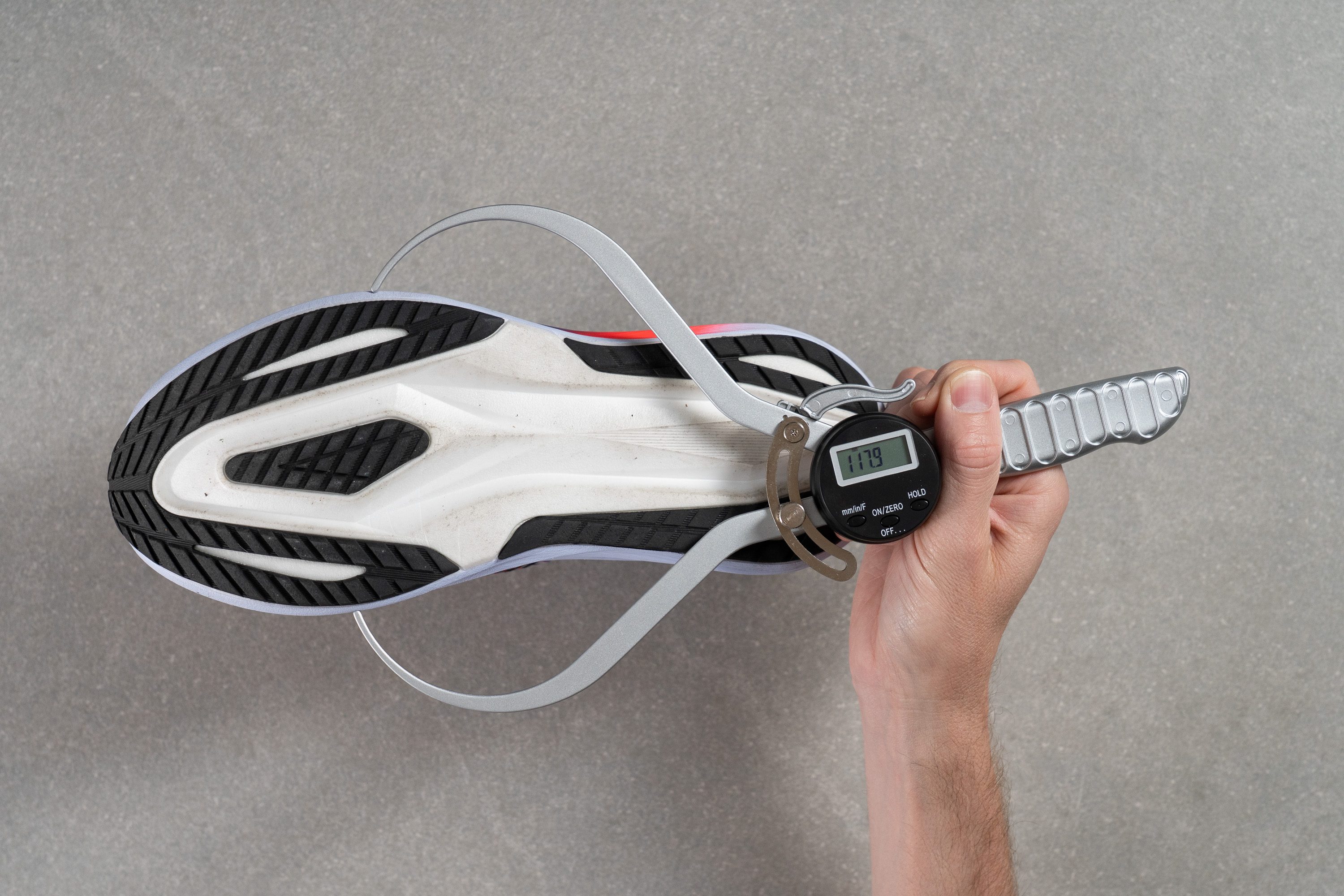
| Megablast | 117.9 mm |
| Average | 114.4 mm |
Midsole width - heel
The heel uses the same design strategy, measuring 95.4 mm, which is wider than average. We discovered that this broader base gives heel strikers extra support and confidence during landing.
However, for midfoot and forefoot strikers, this broader shape offers little benefit since they do not land on that area, and it simply adds a bit of unnecessary weight.
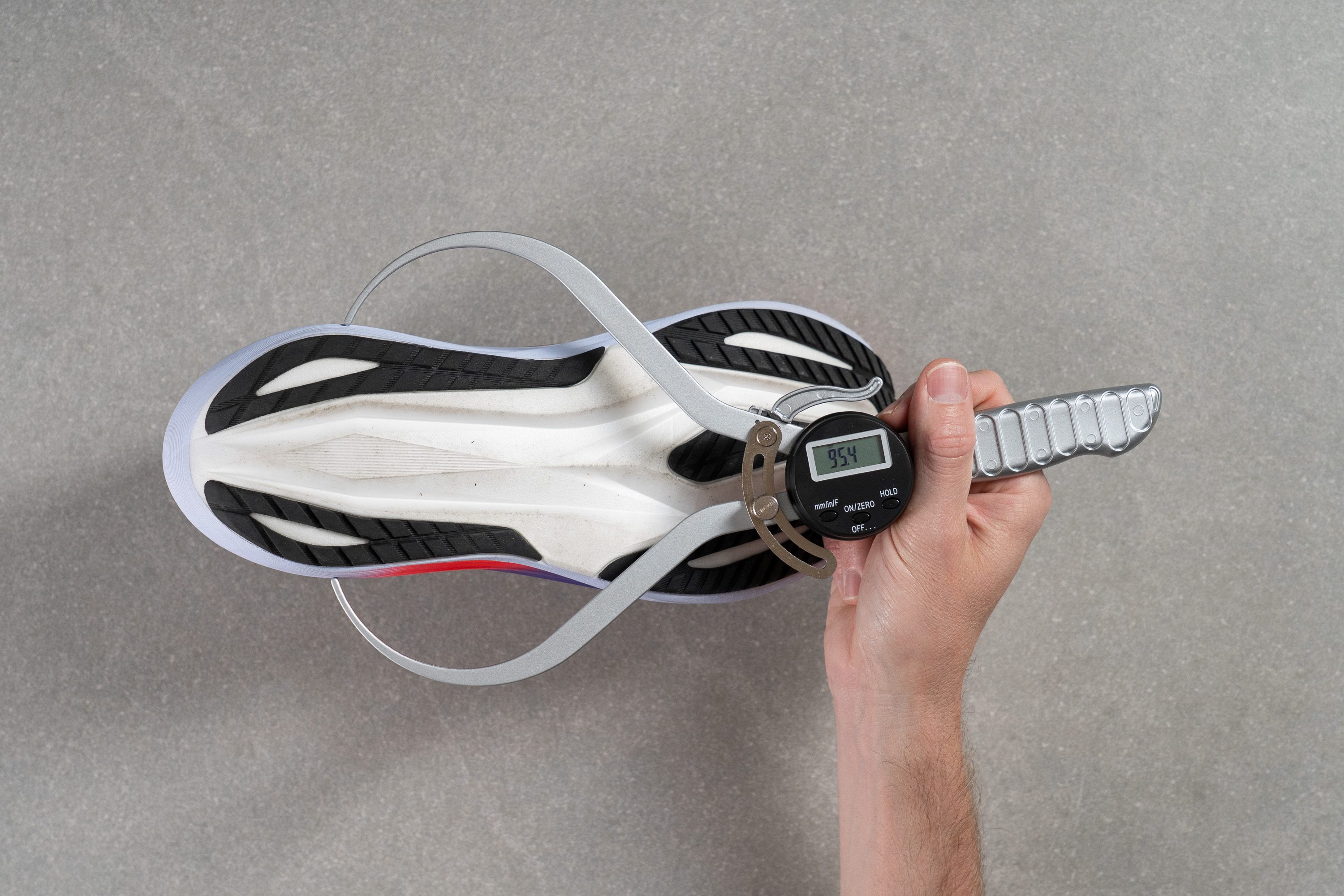
| Megablast | 95.4 mm |
| Average | 90.7 mm |
Durability
Toebox durability
The price to pay for the ultra-lightweight upper isn’t just the premium cost, it’s also durability. In our Dremel test, it performed like most supershoes at 1/5, which came as no surprise to us.
| Megablast | 1 |
| Average | 2.6 |
Heel padding durability
Fortunately, the heel padding proved much more durable, earning a solid 4 out of 5 in our test. This means the Megablast should hold up well even for runners who tend to rub or wear down this area.
| Megablast | 4 |
| Average | 3.4 |
Outsole durability
ASICSGRIP rubber has been one of ASICS’ biggest advancements in recent years. It’s a premium compound that perfectly balances durability and grip while remaining lightweight.
After our Dremel test, we measured only 0.9 mm of wear, a good result that shows strong long-term durability.
| Megablast | 0.9 mm |
| Average | 1.1 mm |
Outsole thickness
It’s impressive that ASICS managed to include 3.0 mm of rubber while keeping the weight remarkably low for such a max-stack shoe. The minimal outsole coverage helps, but it’s still an impressive achievement.
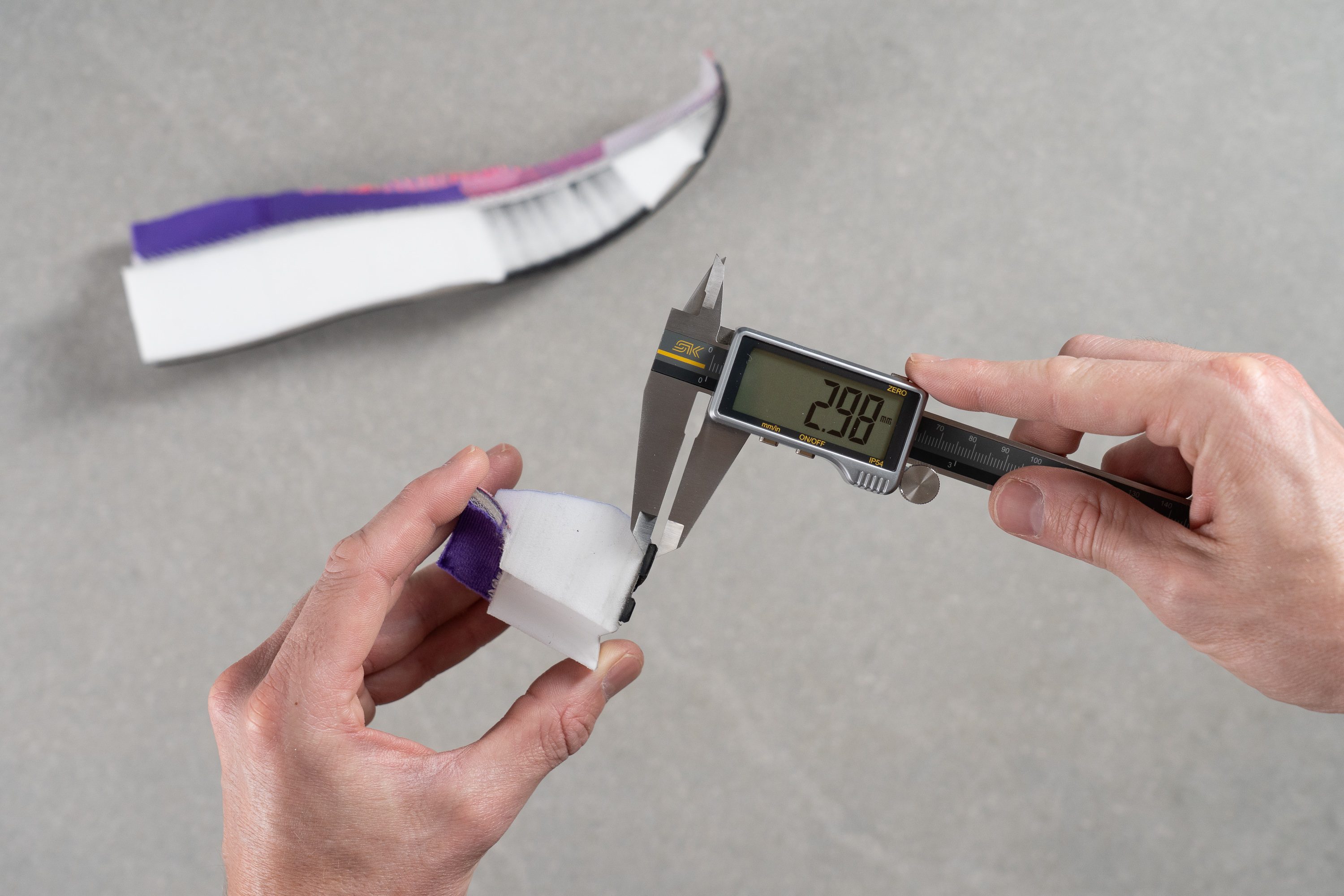
| Megablast | 3.0 mm |
| Average | 3.2 mm |
Misc
Insole thickness
One of the few areas where the Megablast doesn’t aim to outdo other daily trainers is the insole, which is fairly standard at 4.4 mm thick.
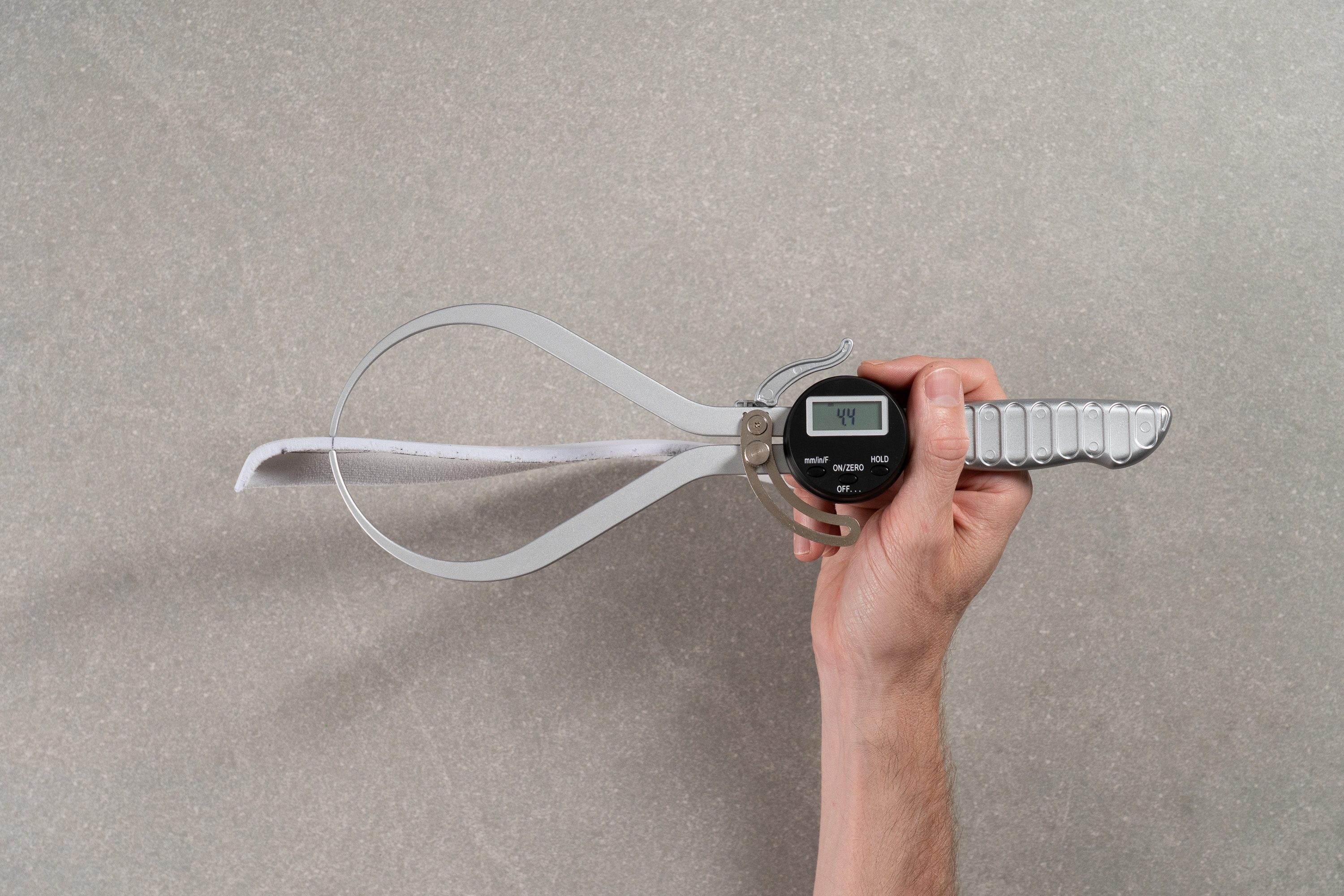
| Megablast | 4.4 mm |
| Average | 4.5 mm |
Removable insole
Want to remove the insole? No problem, it’s not glued to the midsole. We also found that the shoe’s average fit makes it easy to swap in other insoles if needed.
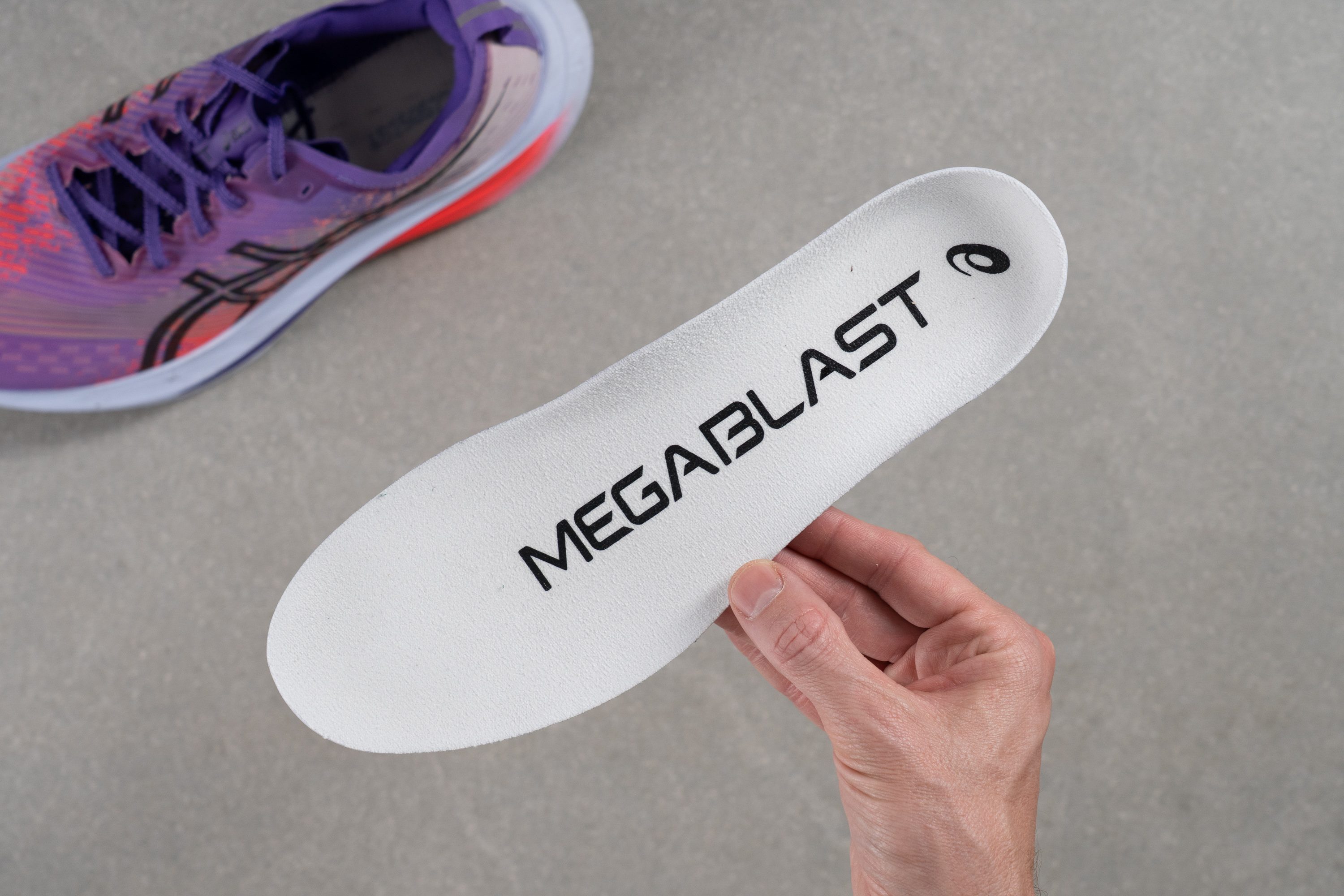
| Megablast | Yes |
Midsole softness in cold (%)
A-TPU is the latest breakthrough in midsole technology, surpassing PEBA while matching its impressive cold-weather performance. After keeping the Megablast in the freezer for 20 minutes, it became only 12% firmer, which is an outstanding result.
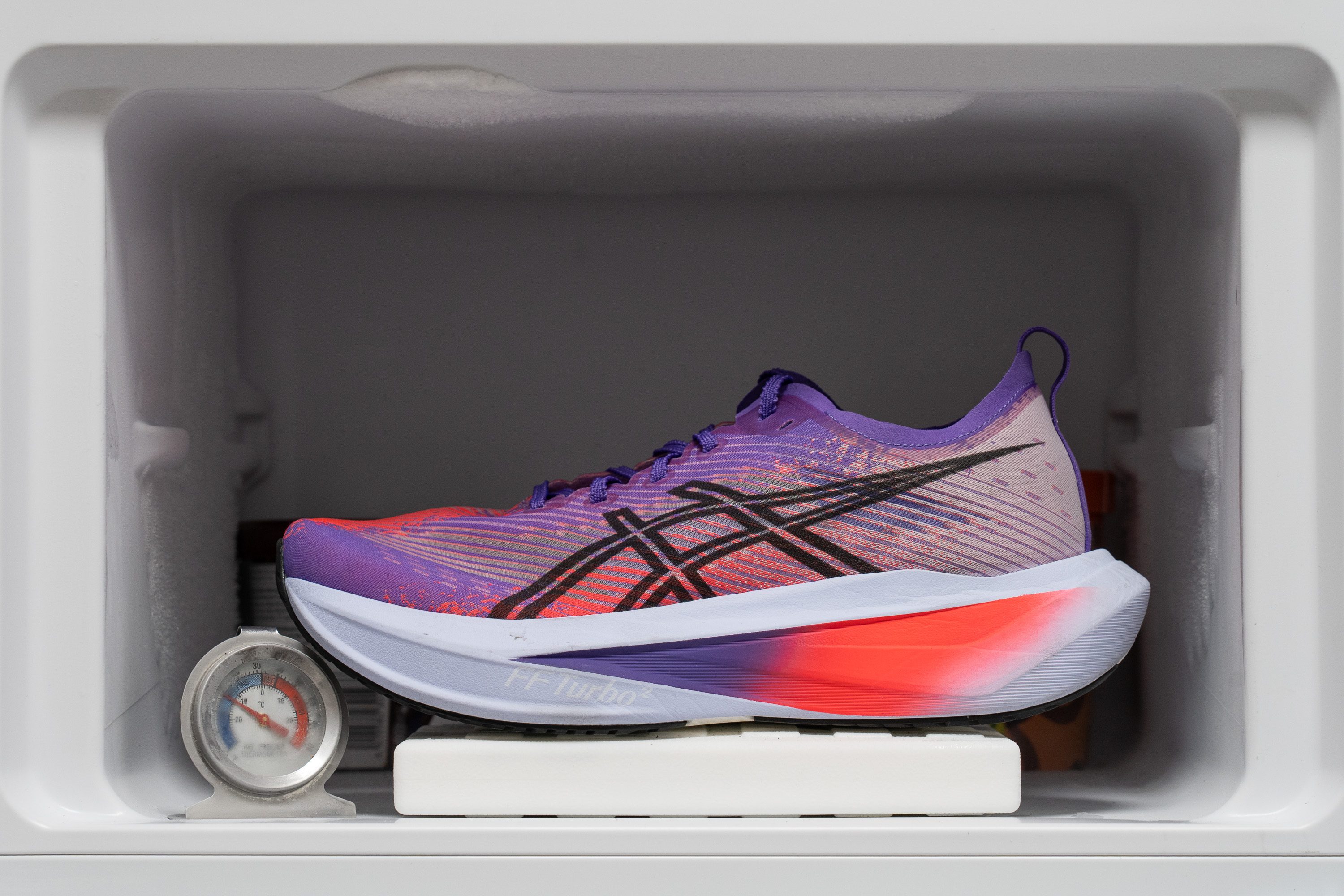
| Megablast | 12% |
| Average | 24% |
Reflective elements
The heel of the shoe features reflective details, a small but welcome addition. It’s not a deciding factor for most buyers, yet it’s another small touch that adds to the overall package.
| Megablast | Yes |
Tongue padding
We truly appreciate when an expensive shoe delivers a secure lockdown with premium, well-crafted laces. That’s why we often criticised Adidas for their cheap ones in supershoes like the Adios Pro 4 and loved that ASICS included top-tier, textured laces in the Megablast.
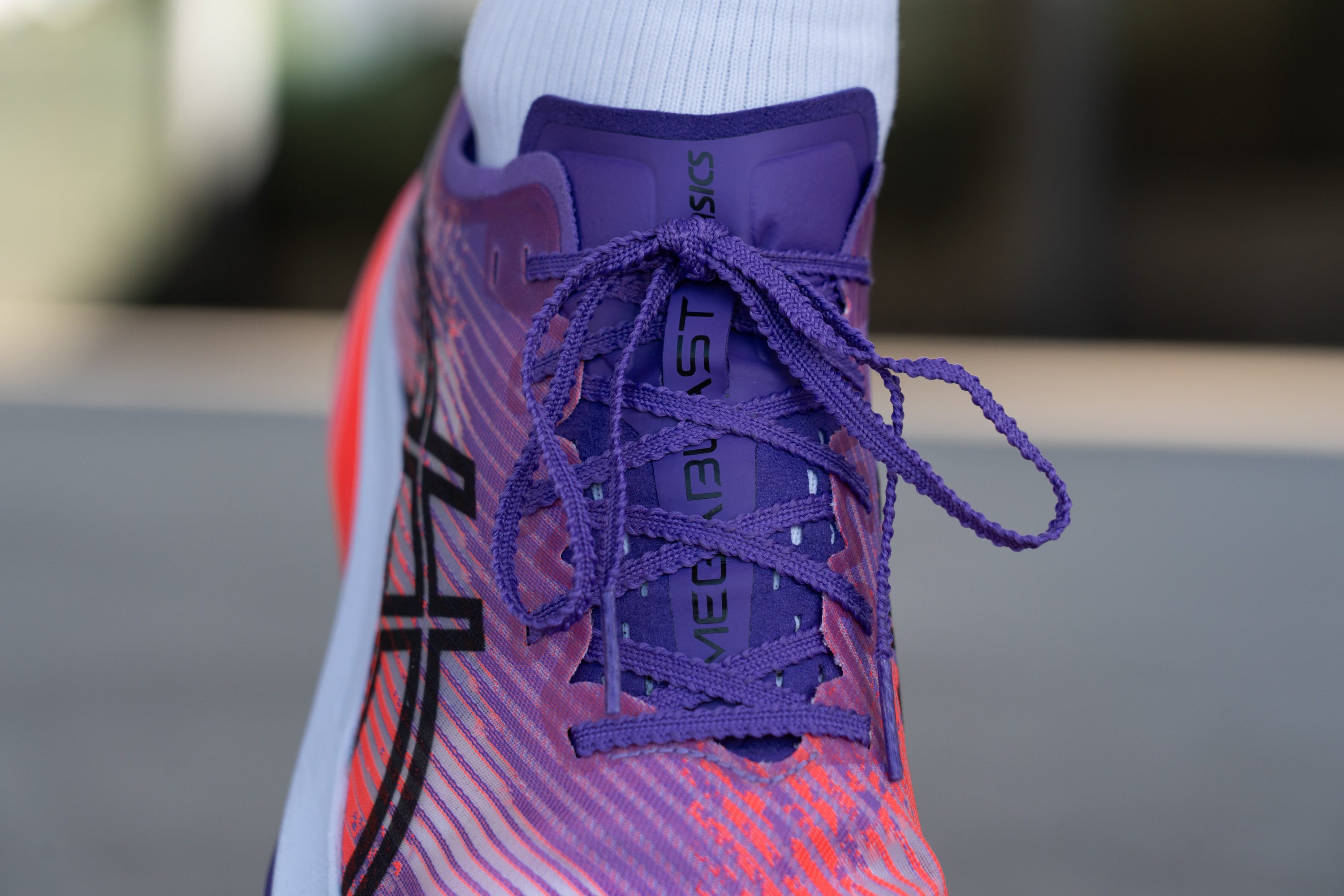
The tongue, as we discovered, has zero almost zero padding (0.9 mm) and requires a careful setup to avoid too much pressure before a run. A small layer of foam could have helped, but ASICS has been consistent with this ultra-minimal approach, and it continues to work well for reducing weight and improve airflow.
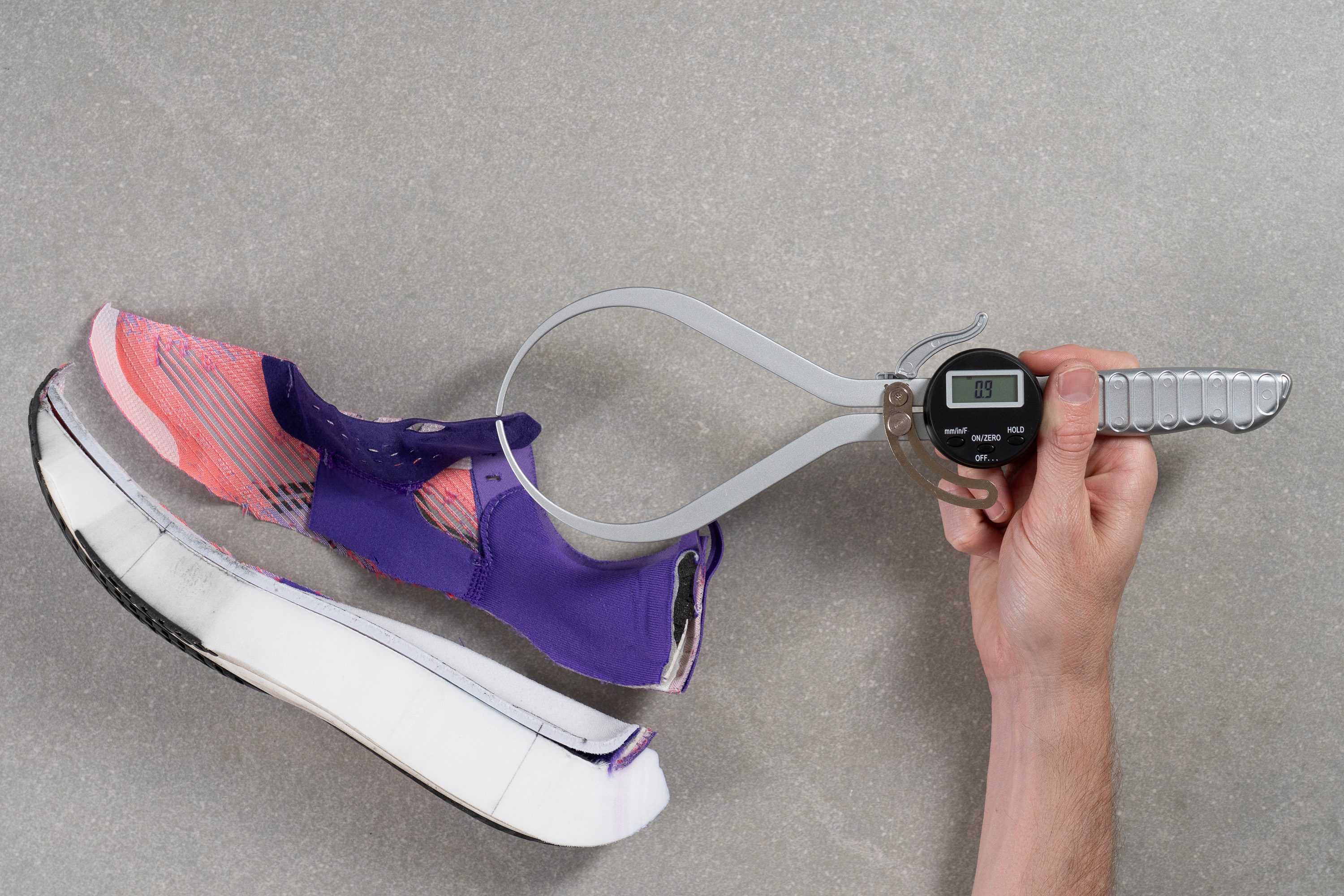
| Megablast | 0.9 mm |
| Average | 5.8 mm |
Tongue: gusset type
The excellent lockdown is one of those small details that, for many runners, makes this shoe worth the extra cost compared to the Adidas EVO SL. It’s fully gusseted and stays perfectly in place.
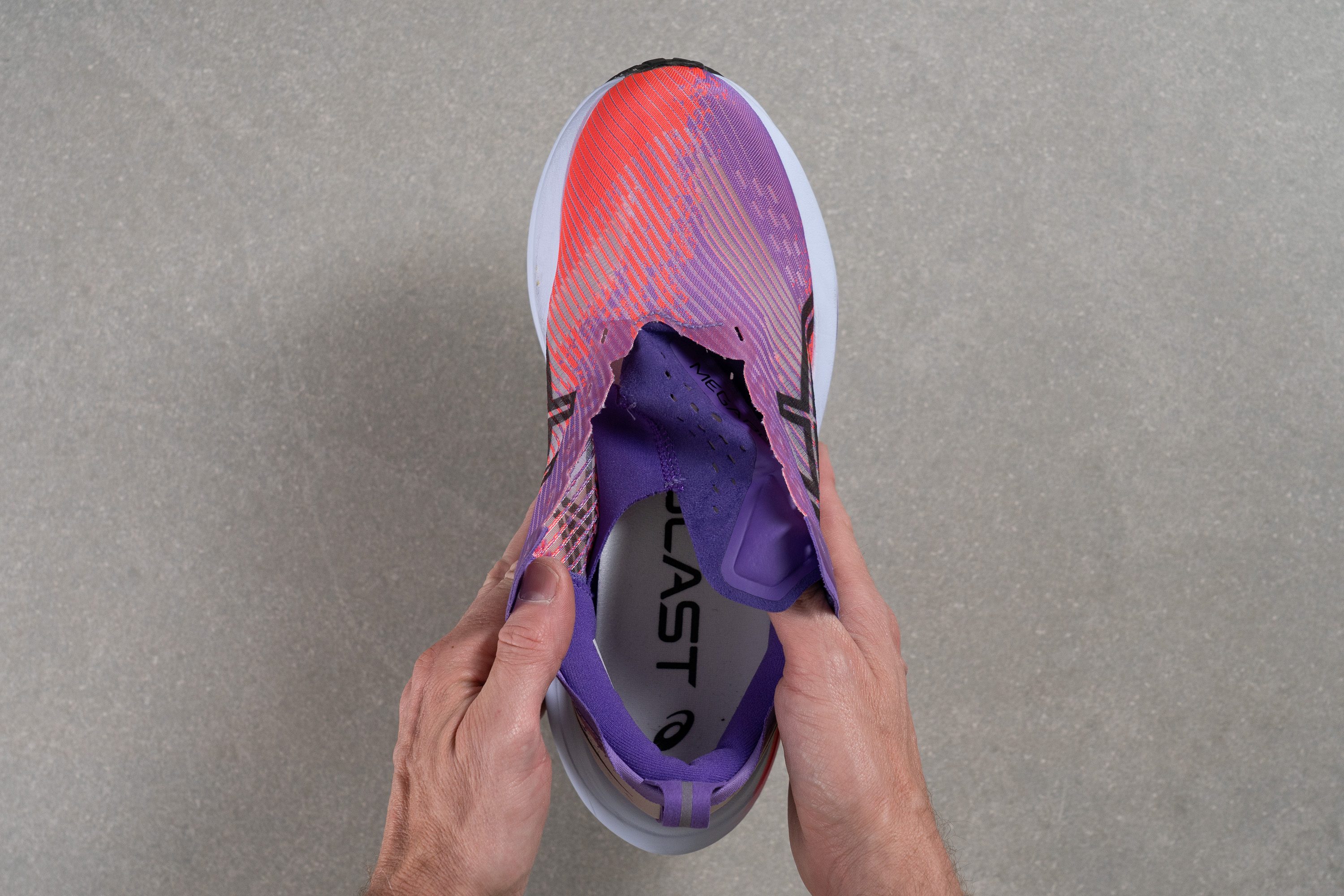
| Megablast | Both sides (full) |
Price
Yes, the ASICS Megablast is undeniably expensive, but we believe that it justifies its price with exceptional performance. It’s remarkably light, super bouncy, and features a premium upper... along with plenty of other strengths. On top of that, it’s impressively versatile, handling daily runs, tempo sessions, and even races!
Don’t get us wrong, we’re not fans of high prices either. We’d love if the Megablast cost 20% or 30% less, and as you probably know, we buy every shoe we test in the lab. But maybe we should question less why state-of-the-art shoes like this are pricey and more why some £140 or £150 models with outdated tech or poor performance keep launching each year. Perhaps those are the truly expensive ones...
| Megablast | $225 |
Heel tab
The heel of the Megablast mirrors other ASICS designs, with a sturdy finger-loop seamlessly integrated into the upper that also neatly hides the back seam.
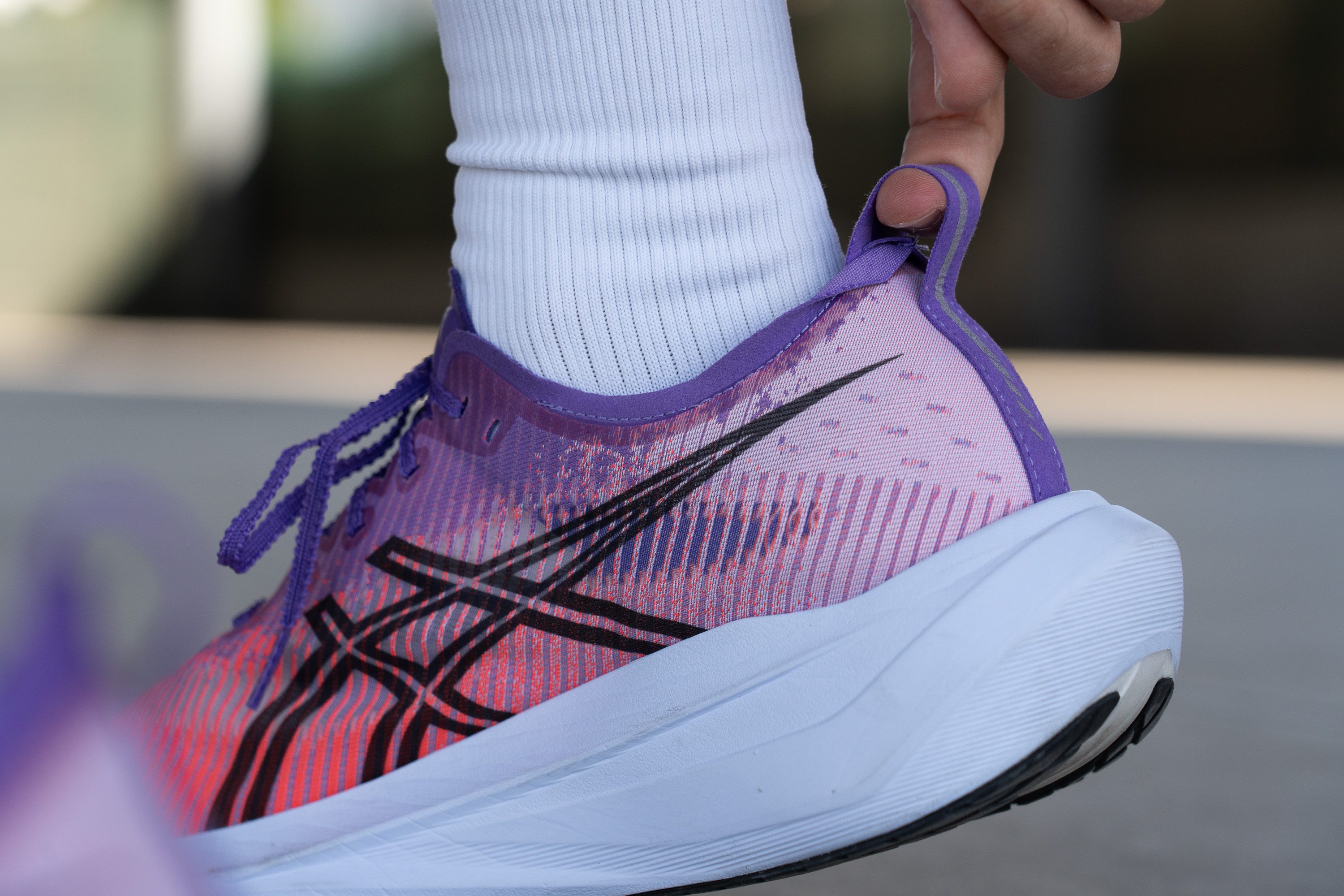
| Megablast | Finger loop |

